#magic of course plays a huge role in this world but it does not define a creature
Explore tagged Tumblr posts
Text

updated oc "family tree" because the last one sucked majorly and did not specify what the hell any of those creatures were. also now we have god lore. and a very long tag rant apparently
#the gods have always existed but it seemed right to put them on the family tree this time around#anyway. now we can specify what individuals of each species may look like which was a great exercise because i was genuinely struggling to#figure out what the difference between dragonfolk and faeries was. turns out the answer was really easy#also tried to specify physical attributes and not magical ones#magic of course plays a huge role in this world but it does not define a creature#specifying that satyrs typically specialise in earth magic becomes redundant when 1. not all of them do that and 2. some have weak/no magic#like calvin! yes he does specialise in earth magic but it is weak to a degree that he is functionally magicless for a long time#and the 'dragonfolk usually spec into fire magic' becomes doubly redundant when pesky only knows ONE fire spell#because they have an inclination towards earth and an unwelcome shove into spirit#also switched the rodent role into just beasts. means that we can have everyones fursona here if we please#anyway note that gods are literally incomprehensible in form and angels are beings of pure magic#describing them as liquid and gas is a very mortal way of doing it. well that one looks wet so it must be liquid and that one is defo clouds#but they show up so infrequently in the mortal realm that a lot of people think theyre fake#speaking of fake - any god being worshipped that is not listed on this tree is either a false god or just straight up fakd#*fake#example of a false god is the wyrm that controls the mountain dragonfolk. it isnt a god but it sure as hell thinks it is#fake gods function a lot like santa. like yes they were based on a real dude but that guy is extremely dead and we have misinterpreted what#really happened so now we think they were a god who just. went back to the astral realm#oak and holly would be considered fake gods. they were once rulers of kingdoms who fought for every square inch of land#but give that a few thousand years and suddenly youre responsible for the changing seasons#which is awesome but unfortunately only two gods exist in this world#this is basically my blueprint for every fantasy story in my mind. things will change over time of course but this is a good starting point#and the typical inclination towards magic types based on species is getting scrapped due to natural variation#individuals are inclined but species often means environmental pressure. it is considered more conventional for satyrs to choose earth#doesnt mean they have to or that they have a drive to based on species. but they are often pressured to choose certain paths#anyway that is far too much tag rambling. back to our regularly scheduled programming (dashboard nuisance)#aureation
1 note
·
View note
Text
BBC's Merlin Season 1 Episode 5: Lancelot Analysis
It's Lancelot's first episode which is tremendously exciting. I remember the first time I watched this show (last year- I really make it sound like it was much longer than it is), I wasn't particularly attached to him but on my second rewatch I loved him, I loved his and Merlin's friendship and I loved his sheer nobility and decency. Lancelot is of course typically one of the most central characters in telling's of the Arthurian legend, so of course his appearance is exciting. Also excitingly an episode where I talk about someone other than Arthur! Yeah, if you can't tell Arthur's my favourite character. I'm not sure how clear my point is throughout all of this, its hard to articulate but I hope I've done it justice.
"Sir Lancelot, the bravest and the most noble of them all"
This is a quote from much later in the show but it explains something very fundamental about Lancelot's character. Lancelot is supposed to be the chivalric ideal, in most versions of the story he is portrayed as such, as the only knight who really comes close to fulfilling it. Lancelot's fault that puts the dent in him being the true epitome of the noble chivalric knight is his love for Guinevere, and its actually his son Galahad (who doesn't exist in Merlin) who achieves this ideal. However, the point remains that Lancelot is almost there, his character is typically about a person who almost achieves this ideal of chivalry, and they run with this in Merlin, out of all the knights he is the most knightly, the most committed, the one most devoted to its ideals.
Lancelot talks like our idea of a knight, its kind of hard to explain but the way he talks is straight out of chivalric romances, out of films about knights. You notice it because everyone in this show talks in quite a contemporary way, its an Arthurian legend for people of today and the characters talk like it, but Lancelot just doesn't, he talks like a knight from a fairytale. It's just a small detail, but it really plays into the perception of Lancelot as the epitome of chivalric honour.
I'd argue that he represents a knighthood Arthur believes in, before he even realises it himself, a kind of honour that's about devotion to one another and helping others and fighting injustice. Arthur and Lancelot do get on extremely well, despite the fact that Lancelot, in Arthur's own words, doesn't sound or look like a knight. His passionate defense of him to his father, as well as the fact that Arthur releases him from prison without his father's approval is because Arthur respects him and admires him and probably because he sees him as a friend. King Arthur's court is often the ideal representation of chivalry, stories like these about chivalrous knights were very important to aristocratic culture in medieval times, and Arthur's court was at the center of it. The thing is that there is a code of honour and chivalry before Arthur in Merlin, the knights of Camelot already exist, and they are often honourable. But Arthur's task will be to reset the idea of chivalry and honour on new grounds, in new ways and Lancelot in many ways exemplifies this ideal
There is a huge emphasis in Lancelot's character in serving with honour:
"It's not my freedom I seek. I only wish to serve with honour."-Lancelot
"He laid down his life for me. He served with honour."- Arthur
"He meant no harm I am sure of it... he only wished to serve."- Arthur
I'm not exactly sure how to define honour, its kind of an abstract concept but I do know what it means, its acting with integrity and respect and honesty. It's a concept central to the Chivalric code, that knights should behave with honour, so its inclusion here further cements the idea of Lancelot's character as representing the ideal of chivalric knighthood. Also the concept of servanthood comes up again, Merlin emphasises (through Merlin most of all) the honour in being a servant, you don't need to be great or noble or a great leader, the world needs people who are willing to serve and that is just as noble as leading.
Chivalry as a concept is inherently bound up in the concept of nobility. The etymology itself is from the French word for knight/horseman, of which only nobles could be. However, one of the points of Merlin through many of its characters is upsetting this class divide so prevalent in Arthurian stories, not just in also including the stories of those who aren't noble but in setting up a code of honour that applies to everybody. Lancelot epitomises this, he is the knight who most represents the ideal of chivalry to Arthur, he's also not a nobleman. Just like making Gwen and Merlin servants, making the most noble knight not a noble sets up this shift, highlighting the capability of everyone to the kind of goodness and nobility that Camelot's ideal will represent. Because fundamentally what's the point of an ideal if it only applies to some people, ideals should inspire everyone to be better, they should make everyone's lives better not just a small subset of people.
As Gwen says that in Arthur's knights "we need ordinary people like you and me."
Arthur and Uther
Importantly Arthur realises the injustice of laws in his father's kingdom and you see the contrast between him and Uther.
"The code bends for no man."
"Then the code is wrong."
Uther is stubborn, we know that, he's unwilling to admit the fault in his rules, in his ideas even when the evidence is right in front of him and that is a fundamental fault, you can see it in his treatment of those who use magic. Arthur by contrast is someone whose views haven't been set, partly because he is still young, but also because he is a better person than Uther in the ways that matter. He's not going to purposefully blind himself to the truth. For Uther he is also one with a worldview of absolutes, all magic users are bad, laws are laws there is no room for argument or nuance, and I'm sure Uther would see accepting argument or nuance as a weakness.
It is also important that in recognising that the code should bend, Arthur recognises the essential flaw in Uther's construction of society and chivalry. The idea that knights should all be noble, Uther literally says that it is the fact that all knights are noble that binds them together, and this is emphasised by the fact that Uther created the first code of Camelot (also the fact that its the first code- makes this seemingly small law much more important). This is a premise Arthur does not agree with it, this episode proves what it really means to be a knight in Lancelot, its a willingness to do your duty and act with honour and self-sacrifice. It is not confined to class, and thus plays into merlin's wider subversion of chivalry as only being for knights, its a code of honour and behaviour that all people can aspire to, and the ability to live and die for noble causes should not be the sole preserve of knights. The Arthurian ideal is so premised on nobility, for the rest of the kingdom, yes they have a just king and presumably they are protected and safe but they are kept from the dignity of being allowed to be noble, being allowed to be considered a part of the nobility and goodness of the Arthurian ideal. It's significant that the first figure to represent this isn't noble.
Other Stuff
"I owe Lancelot my life and I am paying for that in the only way I can."- Merlin--> This is the worldview of knights and debts of honour in its own way as well
Gwen and Lancelot are just awww, like so sweet
"Merlin would do anything for anyone."- Gwen--> True and I love that about Merlin, even as he becomes more jaded as the seasons go on this doesn't change that much—>he's wonderfully decent
"You're the only thing I care about in this world."- Gaius to Merlin--> That was just sweet and kind of sad He's encouraging Merlin to put himself in danger and Merlin reacts with anger because its like does anyone care what happens to him—> but the point is Merlin can help Arthur and no one else can so he has to do it because its his job and its his job because he's the only one who can do it--> Duty is doing what you have to do, doing the right thing even when you don't want to
"It's my duty knight or not."---> Similar to Merlin—> Lancelot believes in being a knight so whether or not he actually is one he has a duty to act like one—> he is a swordsman he is skilled and (theoretically- if they weren't creatures of magic) could defeat a Griffin so he has to do it—> because he can and its his duty to his worldview And Gwen's response- "You really believe that don't you. I don't think I've ever met anyone like you."
"You've already proven that to us"- Arthur "But I must prove it to myself."- Lancelot--> Isn't there just something very noble in that- In the desire to prove your ability to yourself above all others- to hold yourself to a high standard not just to expect things to come Will parallel Arthur in later seasons as he tries to prove his right to be king to himself--> It's funny the scene when Arthur pulls the sword in the stone (much later) is the moment when he proves his right to be king in every version of the story- but usually its proof to others- In Merlin it was trying to prove to himself
"Till next time then, Sir Lancelot."- Merlin- wonderful way to end the episode on an acknowledgement of Lancelot's role in the wider story- he is a legendary figure
#Merlin#bbc arthur#arthur pendragon#merlin bbc#bbc merlin#merlin duty#honour#lancelot#merlin emrys#knights of the round table#chivalry#arthurian legend#merlin analysis#analysis#uther pendragon#servanthood#serve#sir lancelot#guinevere#gwen pendragon#king arthur#knights code#medievalism
23 notes
·
View notes
Text
My Little Pony - I watched all 9 seasons (and you should too)
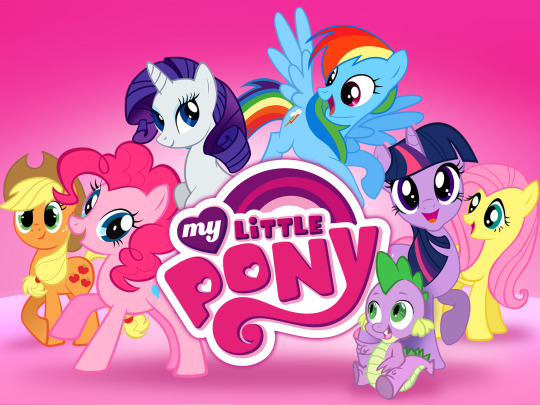
Back in college I went from watching a YouTube video joking about My Little Pony: Friendship is Magic to actually watching the show for myself and realizing that it’s unironically fantastic. I can’t pinpoint an exact year for this, but I imagine it be roughly around 2012? Well, now that it’s 2021, I can finally write down my final thoughts on the show having finished it last year. I picked up where I had left off many years ago, and it’s definitely a come-full-circle feeling.
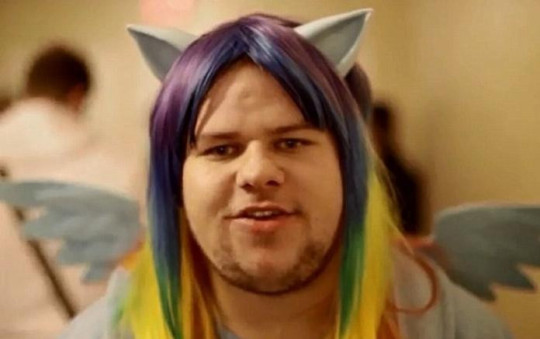
When people think of the MLP brand, especially as it regards MLP: Friendship is Magic, there’s usually only 2 associations that will pop into someone’s mind. Either its target audience of little girls, or worse - the internet phenomenon that was brony culture. Adult men in their 20s and 30s who tuned into the show and used the jokes within the writing & animation on 4chan and other internet boards. Of course there’s definitely more to the brony aspect of the fandom than meets the eye, and any negative stereotypes arising from this association are just that. Stereotypes.
But I think as cringey as the most extreme aspects of what I will refer to as “bronydom” are, I think that these 2 vastly different demographics really does touch on what makes MLP: Friendship is Magic so special. This show that was clearly geared for kids touches on so many universal themes (and does so shockingly well), that anyone can find appreciation for it. And the show deserves nothing less than that - the art style is appealing as all heck, the characters are extraordinarily charming, and the storylines are compelling.
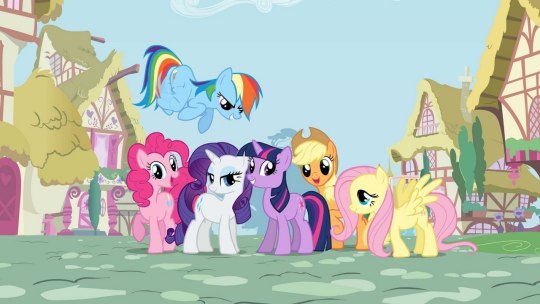
Of course, I will take the time to lay out that the show is at its strongest when looking at the personalities of the core cast of characters - or as they’re best known - The Mane Six. (Yes - that’s mane - not main, haha)

The main protagonist of the show is the unicorn Twilight Sparkle, who excels in academics and is exceptionally talented in magic. But she lacks socialization with her peers, and is sent by her mentor Princess Celestia to the town of Ponyville to make some friends. While there, she meets the rest of the gang -
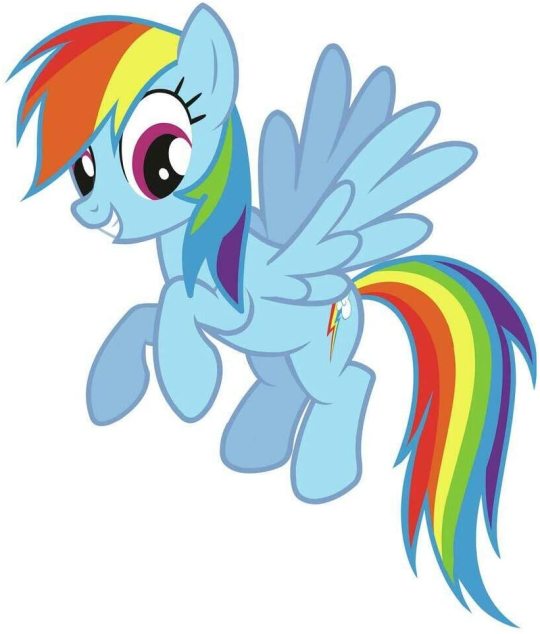
Rainbow Dash, a brash and athletic pegasus who dreams to join Equestria’s most elite flyers - the Wonderbolts.

Applejack - a hardworking and steadfast earth pony who helps run her family’s farm - Sweet Apple Acres.
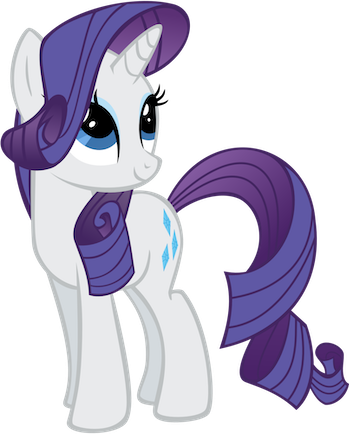
Rarity - a beautiful and fashion forward unicorn who runs her business, Carousel Boutique in Ponyville.

Fluttershy - the sweet and bashful pegasus who has a special talent for caring and connecting to all creatures big and small.
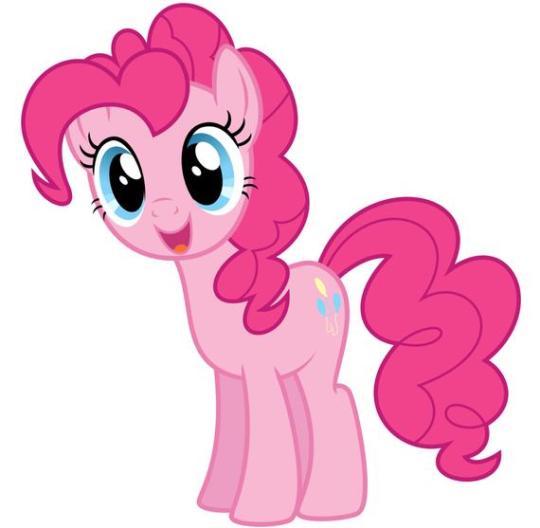
And Pinkie Pie - a spirited and party loving earth pony, whose biggest passion is to make those around her smile and laugh.
These are classic character archetypes, and while MLP: Friendship is Magic boasts solid writing, it cannot boast innovation on that front. But each of the characters do have enough individuality and depth that there are plenty of instances where they veer from their archetype qualities.

Most notably, these characters’ personalities are all flawed - something that is hugely relatable to everyone - children and adults alike. Our flaws define us as much as our strengths. And accordingly, our flaws lead us into conflict. The show is surprisingly realistic about how much that plays into friendships and laying out the lessons to learn from that. While these lessons may be newer to the youngsters that the show is meant to target, they are lessons that should speak strongly to adults as well. After all, we never stop running into conflicts in our relationships, even as we grow older. It’s an achingly human quality that follows us throughout our life. So is it really that surprising when you see the adult demographic that enjoys this “little girls show”?

Furthermore, throughout the 9 year run time of My Little Pony: Friendship is Magic, these conflicts are explored from the show’s beginning to its end thoroughly, and while the cast still consistently must resolve conflicts in each episode, the core cast of characters do not remain the same. They each grow significantly and evolve into mentor and leadership roles. They all take steps to achieving their goals and dreams - together.
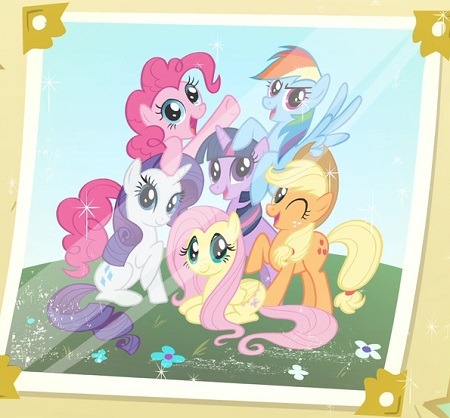
It’s the perfect formula to a long lasting IP. And while certain jokes and gags did get old in the later seasons of the show, and sometimes the writers were a little overzealous in creating character decisions made for arbitrary conflict - fundamentally the writing holds up to the very end. I believe that is specifically due to the poignant quality of the show’s theme: Friendship is not always the easiest to uphold, but the best friendships do make life so much richer and wonderful. Good friendships are worth the work of keeping strong and alive. We are better together than alone.

So as an adult, is it worth checking out this show, beyond the internet culture aspect to it? I would say that anyone who gives the show a legitimate chance will be shocked at how much there is to latch onto and get value out of. There are 9 seasons worth of pop culture references and homages, a gaggle of great side characters (in addition to the core cast), and surprisingly epic moments that had me comparing fight sequences in My Little Pony to fight sequences in shonen anime arcs, and the MCU. (I’m not kidding about that either - this show has insane lore and I recommend this YouTube video series on it: The Complete My Little Pony: Friendship is Magic Timeline (2020) if you want to see the history of Equestria in chronological order. In addition to any epic story arcs, the world building in this show is actually quite massive.)
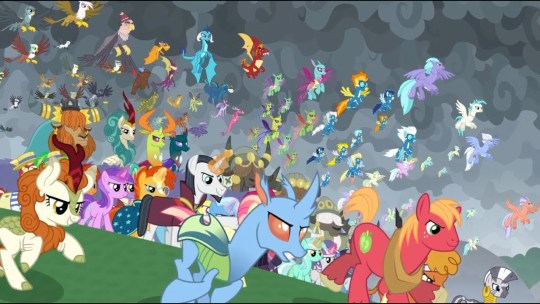
Now admittedly, the show did go through a couple of unnecessary overhaul arcs to keep it alive for longer (as all long running TV shows can be guilty of). But MLP is less egregious in its quality dip than a LOT of other TV content that I’ve consumed. The ending does wrap everything into a neat little bow that as a fan, I was pretty happy with, and I think newcomers into the franchise will be pleased as well.
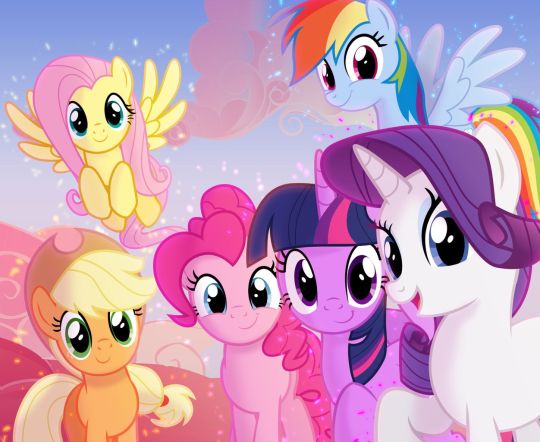
Ultimately, My Little Pony: Friendship is Magic IS something very special. But only can be benefited from, by those who are open minded to seriously consume it. Cheers to my wrapping the show up and giving the later seasons a fair chance. Though it’s outclassed by some other animated content, I would say few to none outclass it within its own genre. And few outclass it even within the confines of animated television as a whole. Friendship forever. :)
#my little pony#my litte pony friendship is magic#mlp friendship is magic#series review#mlp fim#twilight sparkle#fluttershy#rarity#rainbow dash#applejack#pinkie pie
18 notes
·
View notes
Text
House of Mouse: The Stolen Cartoons Review (Patreon Review)

Hello all you happy people! It’s Patreon Review Time. Since my 5 dollar or higherr patreons get 1 review a month, Kevin my 10 dollar patreon is using one of his to celebrate the 20th anniversary of House of Mouse by having me review a random episode a month. And for this month we’re going all the way back to the start with The Stolen Cartoons!
I already introed house of mouse back when I reviewed “The Three Cablleros” episode but for a refresher: House of Mouse is a 2001 cartoon about Mickey and Co running a club. Mickey is host, Minnie plans the show and runs the books, Donald tends to the VIP”s and co owns the club with Mickey, Goofy is head waiter, Daisy runs guest services, Horace is technical support, Clarabelle is a gossip monger with no clear actual job, and Max is Valet. The show was used to repackage shorts from the short lived show Mickey mouseworks, using the club setting as a wraparound and said club was attentend by all the various characters from the disney canon. It’s as awesome as it sounds.
The voice cast, which I didn’t intro thorughly last time, was equally awesome with all the actors for the characters at the time, all legends in the industry. Wayne Allwine as Mickey,who played the character from the late 70′s to his death, Russi Taylor as Minnie and the Triplets, who did the same and was also married to wayne, Tony Anselmo, who should be thorughly familiar to readers of this blog and donald duck fans as his voice since Ducktales, Voice Actress Tress Macneile as Daisy, likewise, Jason Marsden as Max and Voice Acting Legend Jim Cummings as Pete. All except Allweine i’ve profieled before on this blog in various other series, but Wayne, outisde of a very minor role in black cauldron, only voiced Mickey, and to me is the defntiive voice for the guy, though Chris is getting close.
The other notable members of the cast i havent’ covered are April Winchell, who while tremendous, I will save for an episode Clarabelle is actually in more, and Bill Farmer. I have a great amount of Love for Bill and like everyone here, he was a vertran of the industry by the time he showed up in this series. His defining roll far and away is goofy, who was, to my delighted surprise his FIRST voice audition, having studided PInto Colving’s voice well to the point you can barely tell the difference between the two, and having inherited the roll around the same time as Russi and Tony. He’s the voice of Goofy I and most kids from the 80′s onward have grown up with and is the best at the roll by far, having chances for depth and nuance Pinto wasn’t allowed with the Goofy Movies and other works. IN general he’s just THE goofy to me. He’s also the voice of horace and pluto, and currently voices Hop Pop in Amphibia which is super noteworthy as looking at his filmography like a lot of the sensational 6′s va’s he’s only voiced goofy or Pluto for most of his career. But hey like Tony, if you only do one charcter might as well be the fucking best at it. He also has a show on Disney Plus with him and dogs I need to watch yesterday.
So with our cast out of the way, and not much history to go into, join me after the cut and we’ll see how House of Mouse got it’s start and if it was a good one.

Breaking from my usual format for House of Mouse and doing the shorts as they come up int he main story for two reasons: The first is that the shorts are integral to the plot and the second is that there’s way more main story this time around than usual, likely to properly set things up.
So we open at the House of Mouse with Mickey Adressing the club and showing off the general premise of this being a club for all of the various heroes and villains of disney to hang out and what not. He also presents the house rules which are no smoking (Fair and should’ve always been a thing), no villianous schemes and no eating the other guests, all helpfully demonstrated as he says them. We also get to see the others in action: Minnie handling the schedule and the crew, Donald welcoming the guests, and Daisy running the desk and getitng brainwashed by Jafar into giving him a table. Max also is providing his job as Valet which surprised me because I genuinely thought he didn’t join the cast till season 2.. despite the fact he’s right there in the credits.. which are the same for ALL THREE SEASONS.
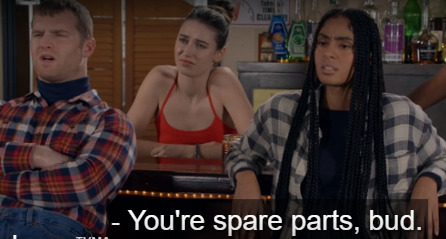
So things are going well.. so naturally that’s when Pete shows up to try and ruin things. Look he’s having a hard time after the divorce.. several years ago. Okay maybe he’s always just been a dick and that’s why he’s divorced in the first place. Point is he naturally wants to shut the club down, boot them out, and wreck up the place like any natural cartoon villian or real estate scum bag landlord. Pete just happens to be both because he can multitask. .and because it’s basically the same thing you just have to be animated for one of them. Thankfully whoever the previous Landlord was, i’m going with Shere Kahn given the setting, his roll in tailspin and the fact the obvious candidate, scrooge, would make no sense here given a later episode where he guest stars, wrote into the contract that as long as the show goes on, they can stay in business. Pete stews over this and naturally plans to stop the show while Minnie, in a cute bit, comforts a nervous mickey and just tells him to play some cartoons. So...
Pluto Gets the Paper: Wet Cement and Donald’s Dynamite: Magic Act I”m covering both of these at once. But as I said the animated shorts this time are one big sized one and two of the shorter ones to make more room for the story. Which is fair: this is the first episode, and thus needs to set up the premise. The series isn’t story driven but your first episode should still feel like one, ease you into the world and get you situated and THEN can do the normal format. It’s also in the episode’s favor as the heavier story focus meant a BETTER story than most season 1 episodes, on par with the two season 3 episodes i’ve covered so far.
The shorts themselves are fine. So far this is the only Pluto Short i’ve liked as it has a neat enough gaga: Pluto has to get the paper in wet cement. Why did the paperboy throw it in wet cement instead of in the driveway, I dunno but given this short is well.. short and just meant to deliver on some quick gags, I’m not going to question it. It’s the first Pluto short i’ve covered without any dog sexual harassment, i’m not looking a gift dog in the mouth.
The other short short played right after is part of a series where Donald ends up trying to get rid of a round bomb that shows up wherever he is....
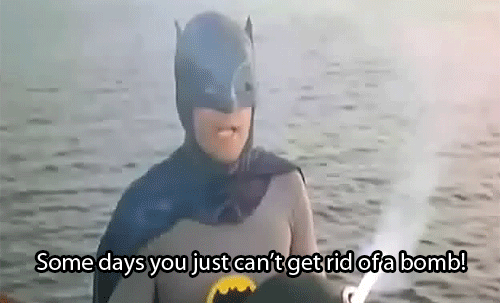
It’s pretty damn funny, though being a huge Donald fan i’m obviously biased, but even removing my donald duck brand sunglasses, I will concede this was objectively fun.
But the cartoons stop as, true to the title, they’ve gone missing! Horace is found tied up, the cartoons are gone and Pete is obviously responsible. and hilariously so as the rope has his name on it and he says “I don’t know horace horsecollar” There are a LOT of good gags in this one, i’m leaving a lot out for time’s sake.
So Mickey and Minnie come up with a plan: Mickey sends the.. Quackstreet Boys.... to stall. Now it may shock you but I actually LIKE the backstreet boys. Not to an extreme amount but I did grow up with them, and even now find their music pretty damn good. No my issue is this parody is weak, mostly running entirely on the title pun. The most I can give them credit for is using the outfits from their second album cover. No I wasn’t kidding I did grow up with them. You saw that everywhere so even if I didn’t enjoy their music then and now, i’d know it. But it just feels really weak, like they had no idea what to DO with the boys and instead just slapped them in a lame parody. It dosen’t help i’m not a fan of the classic version of the boys outside of the comics, as I feel later productions should’ve had them actually be distinct, and it took until 2017 to pull that off with the reboot, something I fear may be undone in future productions. Please.. don’t.. you can have Cristina Vee voice them all, I don’t care about the voice I just want to be able to tell them a apart. So yeah I don’t like it but it dosen’t drag the episode down. Just something I wanted to have a moan about.
So they split up: Mickey, Minnie and Goofy go to shoot a cartoon while Donald runs the club. Naturally he rebrands.. but what really is telling is everyone boos him when he tries to mc.. just for not being Mickey. While Donald does have a massive inferiority complex here, desperately wanting to one up mickey.. with moments like this it’s hard not to see why> He’s JUST as big a star, just as talented , maybe not as nice but just as likeable. He even co-owns the club. But ironically only Mickey Himself, and Daisy of Course, treat him like an equal. To everyone else it’s Mickey’s world and he’s just the sidekick. It’s no wonder he spend sthe entire show desperately trying to outdo mickey: he doesn’t hate the guy, even if he wouldn’t admit it.. but he just wants to be loved too. Sure it’s part ego.
Mickey does return though with the new cartoon. And our only sizeable one so.
Hickory Dickory Mickey: This is a REALLY good one with a simple enough premise; Goofy wants Mickey to take him to the airport at 6am tomorrow.. which Mickey balks at.
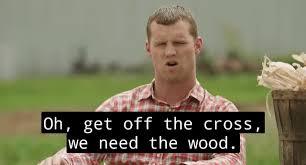
Seriously i’ve woken up at 3-4am to go to the airport or on road trips. Waking up at 5:30 is pretty standard. Goofy also has good reason to ask as he once BROKE MICKEY OUT OF JAIL. And as seen up top the flashback is done in black and white AND with their old models. I just.. love everything about this and it had to have taken extra effort to make new models for the old models and thus extra money for a quick joke. So kudos best part of the episode. But with his hands tied Mickey is forced to take him and Goofy leaves him his clock which won’t stop ticking. So we get just.. nonstop good gags as Mickey tries to sleep with standouts being his trying to drown it out only to get the tick station, the tock station on the radio and the clock channel on the tv. He also tries to mail it and naturally it comes back thanks to a kangaroo when he ships it to Australia..a nd then get’s progressively batshit as he mails it to HADES (comes back in a puff of smoke) and to the 1920′s (It comes back in black and white with arms and legs). It’s just.. really damn good and I suggest seeking it out. I have liked other shorts better but this was a good one.
Pete still gloats as they’ll need more cartoons.. only for one to fall out of his jacket and Mickey to shake the rest out. We then get a fun chase between the two, SO many good jokes, my favorite being him dressing up as a dalmation only for Cruella to take measurements, before being cornered by the three and the elephant from tarzan who throws him out.. right next to pepper-ann and her mom “Don’t touch the villian dear”. Good crossover.. and another show that like House of Mouse is not on disney plus don’t ask me why.
So our heroes win, we get our usual sponsorship and unusually we see the guests leave, a nice bit I wish they did more. All’s well that ends well.
Final Thoughts: This episode was fantastic. It introduces the cast well, sets up our villian, our basic premise and while only having one major cartoon, uses that as a plot point and it’s a damn good one. A fantastic start to the series and frankly the best place to start if your curious about the show. I’d like to thank Kev for sponsoring this review. If you’d like your own review you can look at comissoin details on my blog or get one guaranteed every month by becoming a 5 dollar patreon. You get one guaranteed review a month, acess to my discord server for my patreons, and to pick a short when I do birthday specials. And contributing to my patreon gets me closer to my stretch goals, even one dollar helps. Next goal not only gets reviews of the super ducktales mini series, but also a darkwing duck episode EVERY MONTH. And with the plug done, i’ll see you at the next rainbow.
#house of mouse#mickey mouse#donald duck#peg legged pete#pete pete#minnie mouse#bill farmer#daisy duck#2001#horrace horsecollar#tarzan#pluto#max goof
14 notes
·
View notes
Video
youtube
We’ve finally reached the moment my channel was created for, BioWare officially revealed a brand-new behind the scenes trailer that showcased many gameplay prototypes, concept artwork pieces and next-gen footage that each demonstrate Dragon Age 4’s current production stages, building an overall mood of the game’s vision and direction. And it’s just the best thing to come out of this year.
Saria and myself have already broken down the trailer’s concept art, and gameplay shots in an incredible 45-minute video, that you need to check out if you’re remotely interested in the next Dragon Age game.
However, today I’m delving into every single piece of information that surrounds this new trailer, as we’ve got plenty of news, tweets and tidbits to delve into!
First up though, before the trailer’s release we had a few related tweets from the team regarding the current production of the game.
Production Updates:
In late July, Mark Darrah tweeted some updates about Dragon Age 4’s development. He said: “I realize that most of you are here for Dragon Age news and there hasn't been a lot of that lately...
Let me just run down some things I can say:
1. We are working on the next Dragon Age
2. Yes we are working from home
3. Working from home is harder
4. We are making progress”
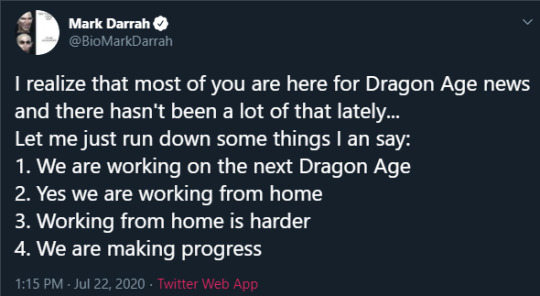
Continuing from that, John Epler retweeted Darrah’s post and said: “WFH is hard! But we're figuring it out, a little better every day. I miss lunches with my team, though.”
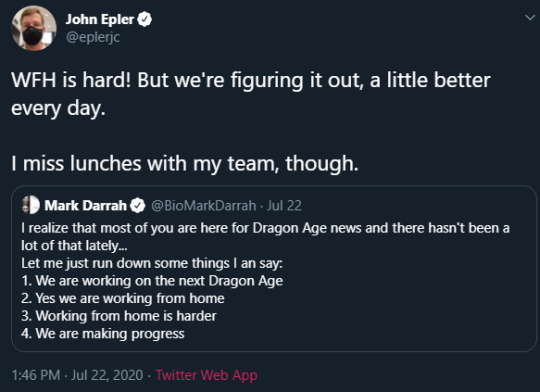
And, Patrick Weekes tweeted: “An exhausting but productive week, with a bunch of folks across the Narrative team coming together for Writer Voltron to look at some stuff and figure out how to make it better. Harder over Zoom, but worth it nevertheless.”
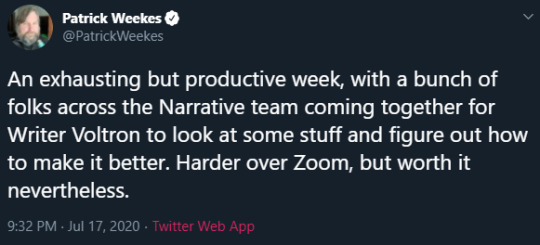
@stoner_gordon asked Patrick: “Writer Voltron? Maybe I’m slow today but what do you mean by that?”
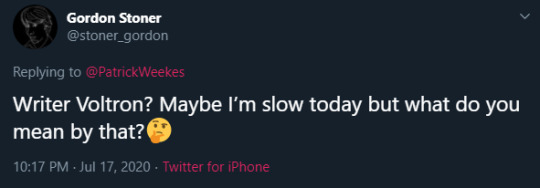
Patrick Weekes replied: “There are things writers can work on for awhile by ourselves. Followers, or individual quests. But some stuff is owned by multiple writers, so we set aside time for all of us (plus non-writers involved with Narrative) to get together and hash things out. That’s Writer Voltron.
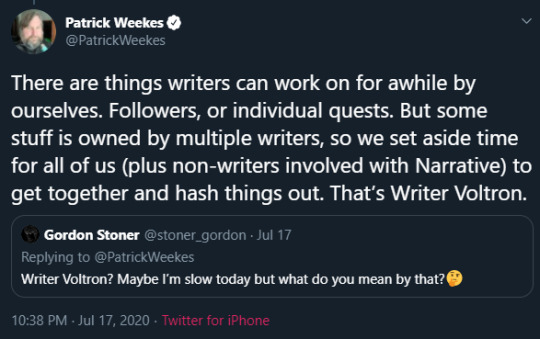
It is mostly a TON of meetings. We go over content and see what works and what doesn’t. It’s also the time where we make big narrative decisions as a team (or make big proposals we then bring to other affected departments).
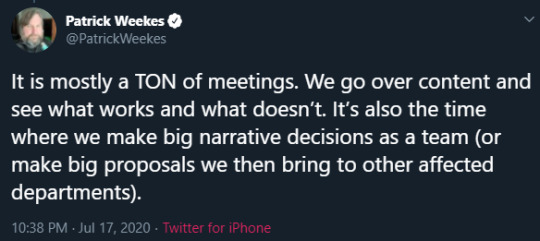
Examples of stuff we decide at things like this:
- Hey, this big story element doesn’t work
- How should we do romances?
- Hey, this big huge thing is unclear
- Does it feel like we’re all making the same game?
We have a great team. It’s positive. We’re all exhausted by Friday.”
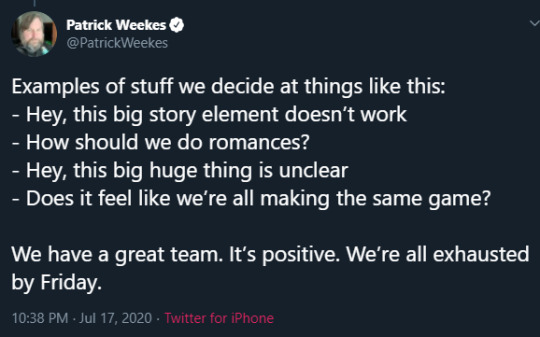
This was a very interesting look at how the writing team are pushing forward during the current world situation, ensuring that each writer can push on with individual work, while tasks that are assigned to many writers are slightly trickier, the team are working it out, while staying as safe as possible. And, I’m always eager to hear how certain things like individual quests, followers and romances are being developed.
Dragon Age Website Update:
With the new trailer’s release, the Dragon Age website was updated. The trailer itself ended on the notion of visiting DragonAge.com.
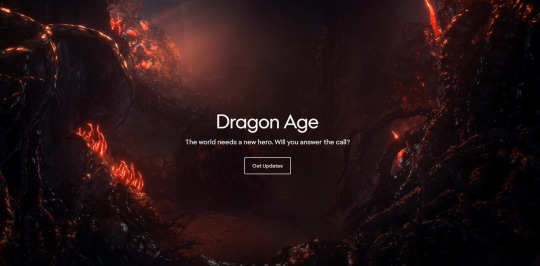
Upon impact to the site, there’s a red lyrium wallpaper with a slogan that says:
The world needs a new hero. Will you answer the call?
“Journey into the world of Thedas in Dragon Age™. Discover new adventures full of striking characters, powerful magic, and rich storytelling. Meet an incredible number of Humans, Elves, Dwarves, and Qunari in a realm where every decision you make echoes across history.”

New protagonist, new adventures, striking characters, powerful magic, rich storytelling, a roster of races with every decision having rippling effects in the world. Each quality that truly define a Dragon Age game. Very exciting to see this!
Behind The Scenes Trailer:
Onwards to the trailer, we have many of the amazing developers sharing plenty of insights into the next Dragon Age game’s vision and development.
Casey Hudson stated their using next generation technology, which will be Anthem’s codebase and tools of the Frostbite engine, to bring the world and characters of Dragon Age to life. And the team are still in early production, I’ve estimated that they’ve been in production stages for around 15 months, since May 2019.
Casey Hudson (General Manager): “We’ve been using next generation technology to bring the world and characters of Dragon Age to life. We’re still in early production.”
Gameplay Designer Melissa Janowicz spoke about creating bosses and how she helps with many of the creature designs, mostly doing the big threats we’ll go up against. This trailer’s concept art certainly paints a picture of many dark, evil monsters to defeat.
Melissa Janowicz (Gameplay Designer): “We’re very experimental here at BioWare, so we’re always coming up with new stuff.”
“I actually design bosses; I help with the creature design team as well. So, I do all of the big threats you have to go up against.”
The Creative Director, and previous Art Director, Matthew Goldman shared that Dragon Age is all about mystery, and hard-boiled detective stories, which is an egg-cellent pun. All wrapped up in a fantasy setting, with an original world.
Matthew Goldman (Creative Director): “The world of Dragon Age has really got it all, it’s got frontier stories, it’s got mystery, it’s got hard-boiled detective stories. And of course, it’s all wrapped up in kind of a fantasy setting.”
“This is an original world, original flora, original wildlife, original architecture, that makes it fun to explore and discover.”
Executive Producer, and proficient teaser, Mark Darrah shared that in the next Dragon Age, we get an opportunity to see new things, new places, and interact with people who lived and grew up in these spaces as well.
There’s a huge emphasis on characters we haven’t met yet, because of course, the Inquisition declared it would look for new people to deal with Solas. We’re going to Northern Thedas, we should expect brand new characters to fall in love with.
Mark Darrah (Executive Producer): “In the next Dragon Age, we get an opportunity to see new things, new places, and interact with people who lived and grew up in these spaces as well.”
Mastermind, and Lead Writer Patrick Weekes shared about the game that currently working on, and how they want to tell a very different story about what happens when you don’t have power, what happens when the people in charge aren’t willing to address the issues.
This time around, we’re playing as a new hero, with not nearly as enough power like the Inquisitor, but instead someone who most likely comes from humble tidings, at a guess, someone like a spy, Antivan Crow, or Lord of Fortune.
No matter the role, our main character will have many conflicts with the predominate people in charge, as they aren’t willing to tackle the issues at stake. I can assume many ideas of course, perhaps the Tevinter Magisterium, The Qunari Invasion, or the Dread Wolf’s scheme.
Whatever powerful force that may ignore the ongoing issues, there’s going to be a lot of conflict from what can assume is going forward thanks to Tevinter Nights.
Patrick Weekes (Lead Writer): “For the game we’re working on now, we want to tell a story – what happens when you don’t have power, what happens when the people in charge aren’t willing to address the issues.”
Arby’s Enthusiast, and Narrative Director John Epler spoke on the things we can expect in the next instalment, there are going to be stories that focus on the people around you, and the friends and family you make.
Every Dragon Age game is about the family we create along the way, expecting more of that, lightens my heart!
John Epler (Narrative Director): “The things you can expect in the next instalment are going to be stories that focus on the people around you, and the friends and family you make.”
“I just love the possibilities that Dragon Age offers us, and I’m excited to explore a lot more of them.”
Associate Producer Jen Cheverie shared that something we’ll be able to look forward to in the next Dragon Age are really close relationships with game characters who really become real for you. I’m so excited to see how relationships and friendships develop in the next game.
Jen Cheverie (Assoc. Producer): “Something we’ll be able to look forward to in Dragon Age is a really close relationship with game characters who really become real for you.”
Foundation Technical Director, Jon Renish, with an amazing beard, spoke on how BioWare want characters to either be loved or hated, the best examples of that is Solas. Half of the community wants to kill him, half the people want to marry him, then another part want to do both.
The fact that the devs can stir these reactions, proves that BioWare can and will create characters that move, and shape us.
If they can make you love or hate a character, they’ve successfully made you care for this world, even if hate is that motivator. However, if you felt nothing for a character, then you wouldn’t have these strong reactions, and wouldn’t feel as connected to the world, or that character.
Jon Renish (Foundation Technical Director): “We want characters to either be loved or hated, one of the best examples of that is Solas. Half of the community wants to kill him, half the people want to marry him, then another part want to do both.”
Lead Creature Animator, Esther Ko confirmed that Dragon Age 4 is being created using motion-matching technology, that will ensure characters will be as realistic as possible, from the way they walk, move and interact.
We saw a sneak peak of Solas’s facial animations, and we can already see the improvement of graphical fidelity and animation quality.
Esther Ko (Lead Creature Animator): “BioWare and EA have been one of the forerunners in using motion matching technology, and that makes it way more realistic for when you're looking at the characters, the way the walk and move, and interact in the world.”
Writer Slyvia Feketekuty spoke on how players want suspension of their disbelief, to believe that the bunch of pixels that make up these characters are actually a living, breathing soul.
Slyvia Feketekuty (Writer): “Players want that suspension of disbelief that this wonderful collection of digital pixels is actually a living breathing soul.”
Gameplay Director Andre Garcia said that choice is a big part of what Dragon Age is as a franchise, the decisions you make can affect change in the world. Reiterating that the next Dragon Age will most certainly surround our choices, with consequences for each.
Andre Garcia (Gameplay Director): “Choice is a big part of what Dragon Age is as a franchise, the decisions you make can affect change in the world.”
Adding more fuel to the fire for choices and consequences, RPG Programmer Katrina Barkwell spoke on decision-making meaning that a party member lives, or a party member dies. Ultimately, choice making means owning your outcome and reactivity to the choices that you do make.
Katrina Barkwell (RPG Programmer): “Decision-making can mean that a party member lives, or a party member dies. And it means owning your outcome and reactivity to the choices that you do make.”
I said in my breakdown, and I’ll say it again here, it was very nice to see a few of the developers that we love and support in this trailer, sharing vital information on the next game. The story about Dragon Age 4’s development is all about the people creating it, and I am so glad that BioWare have an amazing, tremendously talented bunch of people who know what Dragon Age is.
Adding to that, it was so wholesome to see many of the other developers on a zoom call, showing how despite the current world situation, they’re doing all they can to push the development of the next Dragon Age.
Key Trailer Features:
Moving on, throughout the trailer, we had many key features highlighted.
The in-engine shots showcase the next-gen improved fidelity and quality of the Frostbite engine. The reveal of Solas’s facial animations indicate more realistic and life-like animations and scenes, just look at his pearly white teeth, and how his face folds.

And the Gameplay shots reveal a character playing as a warrior, with a sword and shield, wearing Grey Warden armour. Most certainly, the character is a champion specialization, indicated by the “Line in the Sand” ability.
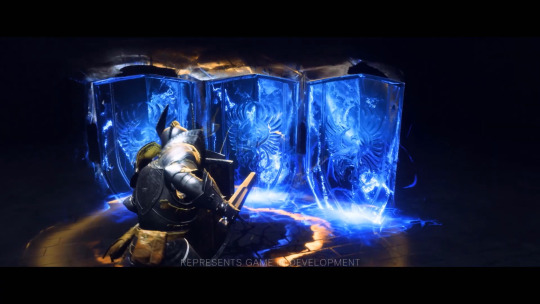
We see them evading, blocking, shield bashing, and preparing to strike. The camera placement is solid, I really like the angle it currently has, I’m hoping it stays like this.
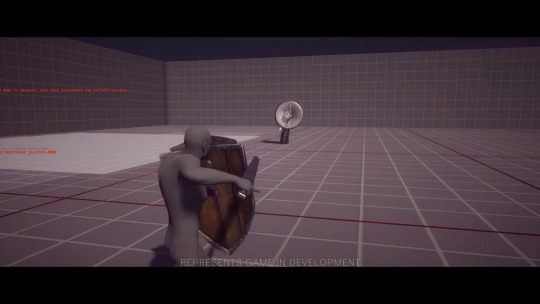
The spider with hands is incredibly frightening, however, beautifully animated. I just hope it’s not going to grab items like the barrel, and throw them at us, when approaching combat.

Two brand-new voice actors were revealed: Jee Young Han & Ike Amadi
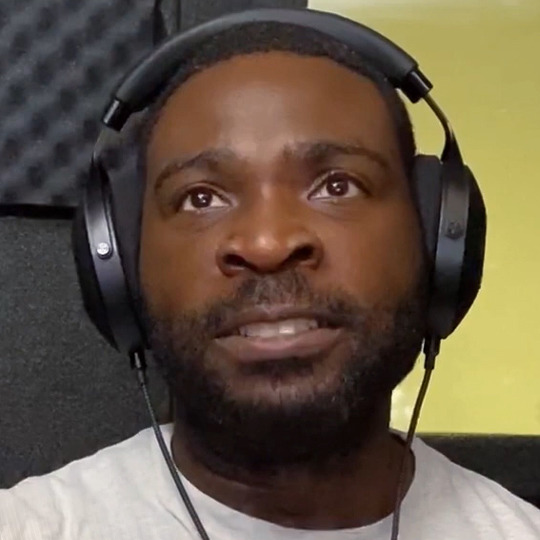
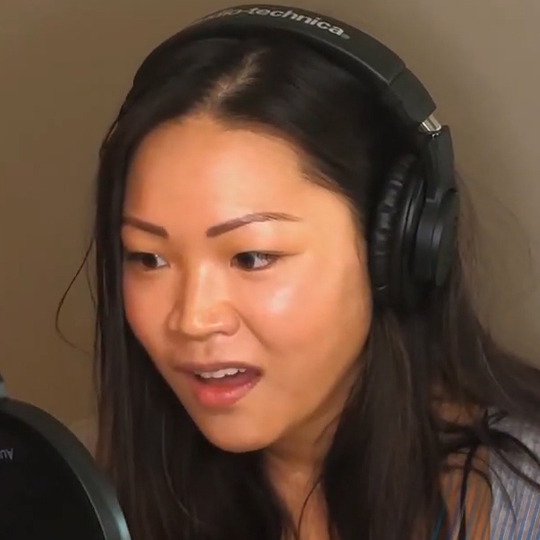
Jee Young Han previously appeared in Anthem, as the character Sentinel Dax. In Dragon Age 4, conceptually, she’s playing a character called “Bellara”, whom I’d suspect is a dwarf, given that Qunari and Dwarves generally have American voice actors. Not to mention her dialogue line of something being “the good kind of rumble.”
Ike Amadi, also appeared in a previous BioWare title, being Mass Effect 3, as he played Javik! It seems he’s playing a character by the name of Davrin. Who is most certainly a Grey Warden, indicated by his dialogue? Perhaps he’s the Grey Warden in Tevinter Nights’ cover, considering none of the characters on the book’s cover appeared in the actual book?
Concept Art:
Moving on, the majority of the trailer features amazing conceptual artwork that reflects the mood, tone, story threads and narrative beats that the developers would like the final game to take inspiration from.
Equally, that means the concepts may or may not appear in the finished project, it’s too early to tell. However, that doesn’t mean we shouldn't pass on dissecting and inspecting the art pieces, because we get a sense of BioWare’s vision, scope and direction for Dragon Age 4.
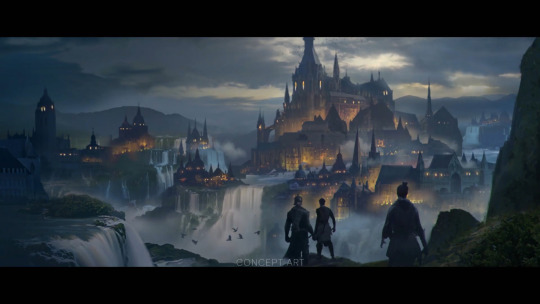
Adding to this, Patrick Weekes tweeted about how concept art is used to create a mood, not to outrightly confirm things, but for a framework. While some concepts may excite you, like “Harley Qun”, don’t get attached just yet because they may, and will change.
To quote Weekes: “We can't answer questions right now about who is or isn't a follower or what story choices we're making. Beyond giving away too much too early, we could also give you the wrong impression and leave you disappointed later. Or we might need to change things between now and ship.
What I can say is that I personally am proud and excited about the game we're making. I hope that came through in the video. I also hope you have fun speculating, even if we can't answer questions right now. You all made a lot of devs' days yesterday. Thanks.”
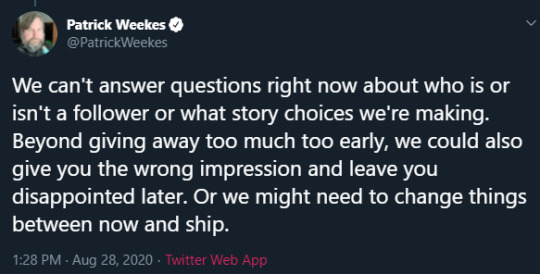
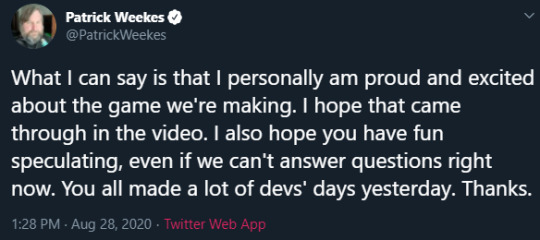
So, while it’s absolutely fun, and amazing to speculate about what these concepts may relate to, and the direction of the next game, don’t get too attached just in case certain plot threads or characters are cut or changed.
Needless to say, me and Saria still have plenty of speculation videos coming up following the trailer, because we find enjoyment in speculation, and seeing how far off from the truth we were when the game actually does ship, I think that’s a good mindset to have.
Regarding the trailer as a whole, I think it’s fair to say it was created as a reaction to what was shown at EA Play. A lot of the fanbase, and people in general were upset with what was shown, however, BioWare listened to us, and delivered this behind the scenes trailer, two months after.
We can tell it was recently filmed too, not to get too stalker-ry, but Patrick Weekes dyed their hair on the 19th, June, which was a day after EA Play.
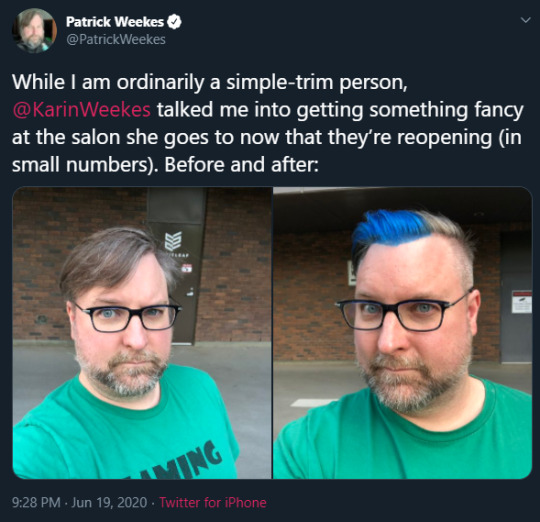
If they had done so before, Weekes’ would’ve had their natural hair-colour in the trailer.
So, even with the current world situation, the developers took the time to film and create this amazing BTS trailer. Speaking on behalf of the entire DA fandom, thank you so much BioWare for giving us a trailer while in very early-production stages. It has been the saving grace of 2020.
Romance Teases:
In other news, we have a few Weekes Tweets that regard romance in the future.
Patrick Weekes retweeted @nevarran-novice saying: “This is my formal request that BioWare give us at least one emotionally damaging romance for every Dragon Age game. Like, literally scoop my soul out and throw it at the wall with the angst. Please.”
Patrick replied with: “I mean I like happy romances with fun positive endings, but the customer is always right!”
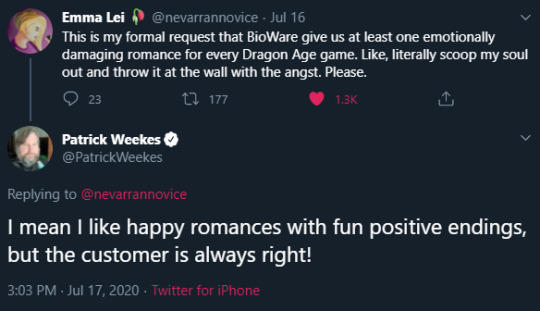
It really is true; we all love pain and tragedy in this fandom, as we play Lost Elf theme at 1 am, sobbing in the night. I’m not the only one, right?
Patrick Weekes tweeted: “Hi, sorry, stumbled across this while looking for something else. Just wanted to say:
- Disliking a character or ship is totally valid and does not hurt my feelings
- Coming into someone’s space to say that what they like or dislike is wrong is bad, sorry that happened to you.
And in games with romances, I believe that the same-sex romances should offer the same spectrum of sweet-to-spicy that the straight options do. If all our m/m romances feel dirty while our m/f romances range from romantic to raunchy, then we need to do better.
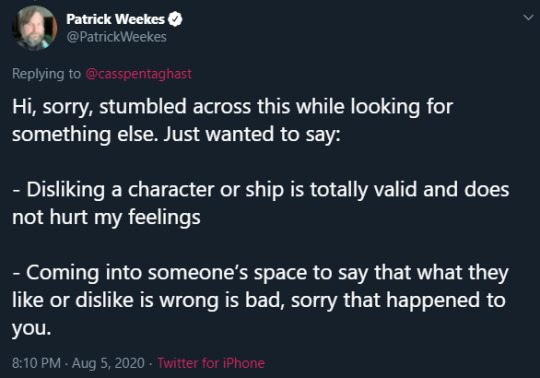
This clearly hints to BioWare making their future romances more tasteful for every type of romance, which is always good, more inclusivity for everyone! In my honest opinion, I don’t need sex scenes to drive romances, while I’m sure I’d love one for a potential Qunari female wife, I don’t need, or desire them for every single character. Sex and romance in moderation; while being tasteful, sounds perfect in my opinion.
In the concept artwork, we saw a sexy, Qunari female, that many of us have dubbed the nickname “Harley Qun”, while it’s really hard not to get attached, it’s nice to see BioWare making this character idea more of a reality.
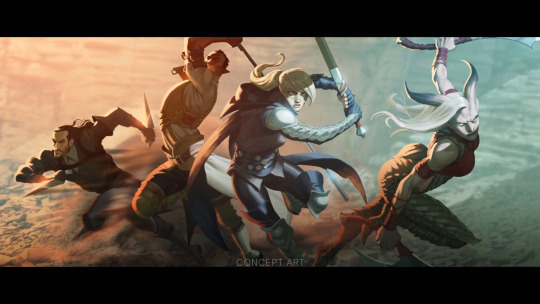
In 2017, a fan asked Weekes about the idea of a strong female Qunari companion. Weekes replied: “definitely a chance. We like doing character types we haven’t down before, and that would be a biggie in hypothetical future game.”
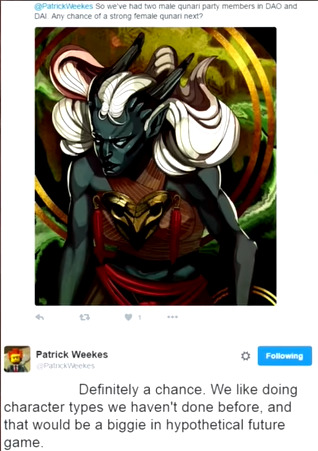
So, while Harley is still just a concept design, there’s much potential for her in the future. I wonder if Patrick is writing her too, not that I’m basing my news on retweets, but Patrick has been retweeting a lot of her fanart. But that could just be because we’re already obsessed with her.
Final romance related tweet, because I didn’t know where else to put this one... Patrick Weekes tweeted: “Is "Dick in a Box" formally a Lonely Island song, or is it technically SNL? It's for work.”
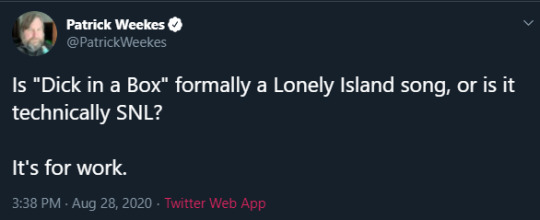
So, erm. Yep, there’s that.
Mark....:
Mark Darrah tweeted: “No release date to share at this time…” Obviously as a joke, for those who don’t know, the next Dragon Age is at least 2-3 years away, according to EA’s 2019 earnings call.
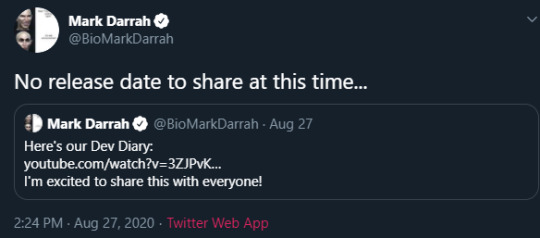
Next Comic:
As a final, very exciting news update, Nunzio DeFillipis, the amazing Dragon Age comic writer, alongside with his wife, Christian Weir posted on Tumblr about the potential of a new comic mini-series:
They replied to autopotion asking about the future of the comics, saying:
“We have another miniseries planned - and it would have come out this year if not for the current world situation shutting down the industry. We don’t want to promise anything, because everything is so up in the air with the entire world right now. But what we can say is that if and when there is another miniseries, it will wrap up the story we’ve been telling since Knight Errant. We will then aim to tell more stories, but one thing at a time.”
“Wish we could say more. Because we have a LOT to say, we promise. Hopefully we can talk about things soon.”
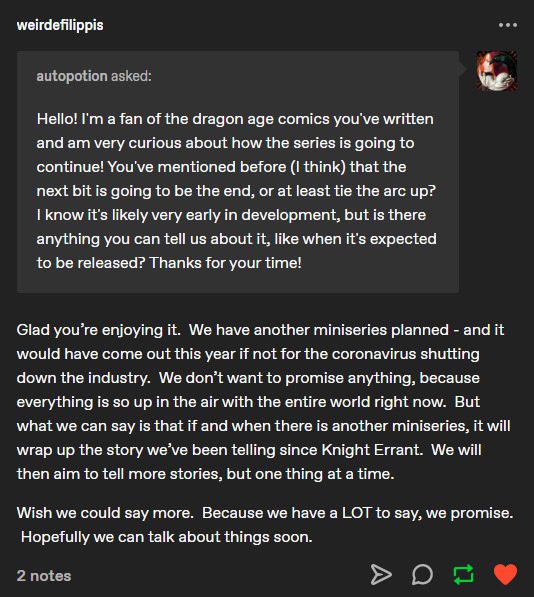
As an absolute fan of each of the Dragon Age comics, the fact that most certainly another one is on its way, and it will end the narrative since Knight Errant excites the crap out of me. Originally, it seems we would’ve had two comic launches this year, Blue Wratih to start year, and one following from that, ending 2020.
I imagine we’ll see this project back on track soon. It sounds as if this one may be a conclusion to the current comic roster, and after that, we may get brand new stories explored in other comics. While that’s quite far off, I adore this team behind the comics, and eagerly await an update to their stories.
With all that said, that’s a wrap for this most exciting news update, I’m honestly so excited to be creating Dragon Age content at the moment, making videos that I’ve dreamed about creating for so long. Check out my latest breakdown, and if you’re new, why not follow me, you’re in the best place to be informed on all things Dragon Age related. From the lore to speculation and news, I have it all here.
#dragon age 4#dragon age#dragon age news#bioware#dragon age behind the scenes#dragon age news update#dragon age next#next dragon age game news#next dragon age#news dragon age#dragon age comics#dragon age next comic#dragon age next game#thedas#solas#tevinter imperium#dragon age game#dragon age concept art#dragon age romance#dragon age gameplay#dragon age shots#dragon age trailer
39 notes
·
View notes
Text


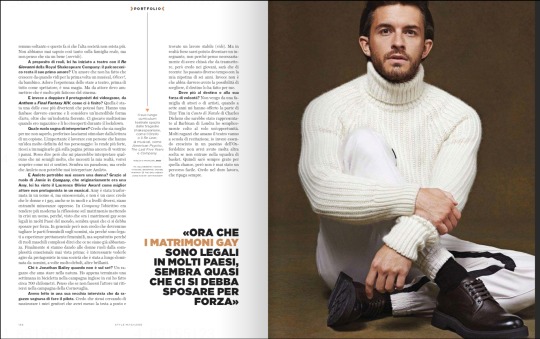
Interview with Jonathan Bailey in Style Magazine (October 2020) where he talks a little bit about Bridgerton. The interview was conducted in English, transcribed into Italian, and then translated back into English by Google Translate so, you know, there are some things that get lost in translation.
Love affairs, marriages of interest and intrigues. It is the portrayal of the new Netflix series Bridgerton, a bit of a Jane Austen romance, a bit of sexy in the wake of The Favourite, with the right dose of Downton Abbey-style family drama, but “so modern that it could almost be set in the present day” enthusiastically states Jonathan Bailey, at his great opportunity to really make it internationally, playing the fascinating bachelor Anthony Bridgerton, the quintessential English nobleman of the early nineteenth century, who at the age of 28 finds himself at the head of a clan of seven brothers and sisters. One who “has to play the part of a loving brother and son and instead loves women and forbidden pleasures” ...
The Regency period has been less represented than other moments in British history, but the film industry abounds with period dramas. Do they still make sense today? Our instincts are the same, in 2020 as in 1820, and to observe them in a restrictive and oppressive context such as 19th century England where the will of the individual was stifled, sexuality was suppressed and there was a strong division between the social classes, puts them even more in evidence. Each of us at some point in his life felt forced into a role due to the expectations of others, just like Bridgerton's characters.
Women more than men, but ... Only in appearance: of course all the decisions are up to men, and Anthony for example to decide who should marry Daphne, but they are also forced to repress their feelings, which makes them unable to live a happy life. Patriarchal society has wreaked havoc on both sexes.
Bridgerton also has the virtue of surrounding Queen Charlotte with a court that is not exclusively white: the terrifying Lady Danbury and played by Adjoa Andoh, Regé-Jean Page plays the role of Duke Simon Basset and Martins Imhangbe as his best friend. Is it worth abdicating historical accuracy to be politically correct? We decided to do the opposite of whitewashing that so many historical moments have suffered. Here the question is to be faithful to the events told in the books by Julia Quinn from which the series is based, not to be historically accurate, so we can also imagine that at the time of Queen Charlotte it could have been an inclusive court. custom and the freedom given to the actors to model the characters, to make them current.
The fourth season of The Crown will also arrive on Netflix in the coming months: have you wondered why the public is still so fascinated by the nobility? We all love what we cannot have, which is closed to us. Even without getting to the royal family. Think for example of the world of the Bennet sisters and Mr Darcy of Pride and Prejudice: they were far below the social hierarchy, yet they have been represented countless times in period films. Personally, what intrigues me most about the golden world of the aristocracy is not the parties and privileges, but what lies beneath the surface: I wonder what the human cost of that life is. Bridgerton's characters always pretend to be something other than who they are: the real drama and their distance from the truth in a society of appearance, and this is what intrigues us about them.
Is the society of appearance then different from ours? If at the time classism was based on the distance between people, with the aristocrats who did everything to limit what the people could know about them, today social media allow us to <approach> characters that otherwise we would only idealize and this does so that high society no longer exists. We never knew so much about the royal family, but I don't think it's good.
Speaking of royalty, you started in the theater with the King John of the Royal Shakespeare Company: is the stage still your first love? A love that has only grown since I first saw a musical Oliver! as a child. I love the experience of being in the theater, first of all as a spectator, it's magic. But as an actor I have to admit that it's much more tiring than cinema.
And instead to dub the protagonists of the video games from Anthem and Final Fantasy XIV, how did he end up? That was one of the funniest things I could do. They have a really huge fanbase and I consider them an incredible art form as well as a thriving industry. He played them a lot when I was a kid and I rediscovered them during the lockdown.
What role do you dream of playing? I think it's better for me not to know, I prefer to be stimulated by reading a script. The important thing is to work with people who have a very defined idea of your character: it makes him stronger, you can already imagine him on the page even before taking on his shoes. But I can say that I'd like to play someone who looks a lot like me, who tells my reality, I'd like to find out how I would feel. It sounds like a paradox, but I think Hamlet could never play Hamlet.
And could Hamlet ever be a woman? Thanks to the role of Jamie in Company, who was originally an Amy, you won the Laurence Olivier Award for Best Supporting Actor in a Musical. Amy was transformed into a man, yes, but homosexual, and it is no coincidence: I believe that women and gays, even if in different ways and at different levels, are both oppressed minorities. In Company the goal was to make the reflection on marriage more modern by putting a man in crisis, because, given that gay marriages are now legal in many countries of the world, it almost seems that one has to marry by force. In general, however, I don't think we should cut the female parts on men, both because they are related to purely female experiences, but above all because of complex male roles I would say that there are already enough. Women are finally being given roles with an emotional complexity never seen before: it is interesting to see them act as protagonists in a society that has long been dominated by men, sometimes very weak, others brilliant.
Who is Jonathan Bailey when he's not on set? A boy who loves being in nature. I just finished a week of cycling in the English countryside where I covered about 700km. I think if I wasn't an actor I would retire Cornish hut.
I had read in an old interview with him that as a boy he dreamed of becoming a pilot. I think I was trying to reassure my parents that I would settle down and find a stable job (laughs). But in reality maybe I could have become a teacher, not because I necessarily think I have who knows what to pass on, but I believe in young people, it will be that I recently spent some time with my six year old niece. Instead it is not that I really had the opportunity to choose, fate did it for me.
Does it owe more to fate or to his willpower? I don't come from a family of actors or artists, when at the age of seven I was offered the part of Tiny Tim in Charles Dickens’ A Christmas Carol which was to be performed at the Barbican in London I simply jumped at an opportunity. Many kids who love theater go to drama school, but having grown up in a small town in Oxfordshire, I wouldn't have had much choice but to join the basketball team. So I will always be grateful for that chance, but it has never been an easy path. I believe in hard work, which always rewards.
10 notes
·
View notes
Text
Submitted via Google Form: So, I have created a map, putting in cities with distances and stuff. But I am having a lot of trouble with transportation between places.
I am not sure about the real logistics of time, engineering, traffic, etc to have my transportation suitable and efficient.
Say, differences between actual high speed bullet trains, just high speed express trains, local trains and maybe areas they serve. Buses that bypass big cities, going through mountains to get to smaller towns?
I'm kinda attempting to design a whole entire system here actually but making it realistic is well, so hard. In actual real life, I always can't even understand the logistics of real transportation and keep wondering why there is no transportation between A and B, or even simple things like how very low speed cheap transportation like trams still actually work. And... that's just public transport. I also need to work on private transport as well, and you know, the oh so varying road signs, speed limits, laws, etc etc.
I have been actually attempting research on real life. I mean, sometimes I can get it. But, when faced with my own story, it's all a mess. I certainly don't have the facts and I'm messed up.
Feral: In brief, as with any cultural artifact, transportation is a social construct. The how’s and the why’s depend very heavily on the terrain the transportation will cross, the resources the infrastructure requires, and the economic and/or civil value of building up one type of transportation or building up of one area with transportation over another. Factors like politics, classicism, and racism play a huge role, especially if you are looking at American transportation networks and lack thereof.
The thing to keep in mind when trying for verisimilitude with worldbuilding is that most cities aren’t planned. Or if the center is planned, the rest grows organically as they city population grows. Most cities were well developed before the idea of public transportation systems or the need for travel by paved roads was a thing. Some defining features of cities that seem planned from the beginning were in fact, not, and only exist because someone was really inventive. See for example, the subway system of New York or the Boulevards of Paris. For writing purposes, if it is truly necessary for your story (like if you’re writing road-trip style narrative) and you need the kind of detail that a complete work up of transportation would provide, I recommend picking one or two real world examples that are culturally similar to the city or cities you are designing and just kinda… borrow.
Constablewrites: For me, the biggest thing that triggers my plausibility Spidey-sense is the amount of time it takes to get between places. Like, when you have horses covering 200 miles in a day, or people popping instantaneously around Los Angeles between locations that would still be 30 minutes apart even if there were magically no traffic.
Now, sometimes this falls under acceptable breaks with reality. (Would 24 have really worked if Jack had to spend an episode and a half sitting on the 405?) But I feel like in most cases, as long as the length of the trip isn’t way off in either direction given the mode of transportation, technology level, and other established facts about the setting, you don’t need to dig too deeply into the details.
Tex: Congratulations on discovering the field of civil engineering! To be more specific, transportation and traffic engineering. While Feral and Constablewrites bring up excellent points, I will gently deposit a grab-bag of engineering for your perusal:
PDF - Fundamentals of Transportation by Wikimedia
The profile of Kara M. Kockelman, Ph.D., P.E., as hosted on the Cockrell School of Engineering
PDF - Transport Planning and Engineering, as edited by CA O’Flaherty
PDFDrive’s myriad selection of transportation engineering textbook PDFs
PDF - Railroad Engineering 101: Session 38, as presented by David Wilcock
Railway engineering has a lot of subfields, so you’ll need to be specific on that front. As in nature, engineering relies upon a significant amount of observation. Which cities use what transportation methods, and in what mixture? Why did they pick those? What’s the history behind those decisions? How much does the environment impact these decisions, and how much do cultural biases?
You’ve mentioned that you’ve already come up with cities and their relative distances - how did you come to these conclusions? What are the personalities of these cities? How do they interact with each other? Again, what is the environment like? What’s their level of technological advancement? How much money do these cities receive from their state, or from municipal tax revenue? What are their priorities in transportation?
It sounds like you wish to know the entire depth and breadth of a topic before you muck about in its waters - this is unrealistic, as in real life even the best-trained, most-experienced engineers don’t know everything. Figure out your priorities, and figure out what this world of yours requires in terms of transportation. Get the goals written down first and then work from there - that’s realistic, as is attempting to figure out the solutions to your stumbling blocks. Sometimes the most inane-sounding, ridiculous thing works and it’s not immediately apparent.
Bina: I’ll first answer some of your questions regarding why real life transport has the structure it does, then I’ll give you some advice on how to make “realistic” transportation for your map.
Why is there no transportation between A and B? Why not make a new path? The answer is typically because it’s already possible to get from A to B in an indirect way. And if it’s *possible* to get from A to B, why spend the time, money, and labor *optimizing* the path from A to B? Why spend potentially millions of dollars and months of construction just to cut time off a commute that’s already doable? If it ain’t broke, don’t fix it. Furthermore, maybe there’s other external reasons. Maybe there’s a huge nature reserve between A and B. Or private property owned by someone who won’t allow the government to build across it. Or maybe the land is already reserved for some other project.
Now, why was there no transport between A and B to begin with? Well, lots of reasons. Maybe the landscape doesn’t allow it. Maybe the ground is too soft to build on, or there’s mountains too large to blast through, or the technology at the time means that a direct path isn't feasible and it's all you can do to go an indirect way. Another reason is because maybe a C existed first that was closer to A, with a path from A to C already in place. When B came up, it was easier to go from C to B rather than make the longer path from A to B. Years later it may be the case that C becomes an unimportant town and A and B are bustling hubs that people travel between frequently, but... why make a new road when one already exists? If it ain’t broke, don’t fix it.
That same ideology applies to why “outdated” systems of transport are still operating today. If it works, why take the time and money to tear it down, pave it over, and replace it with something else? Even if these trams or carriages or what-have-you are a waste of money to maintain, a city might keep them for a number of reasons. Maybe they’re a cultural hallmark of the city and tourists love them. Maybe they service niche areas and the outcry of removing access to/from those areas would be huge. Maybe they operate in areas that are impossible for the city to safely and easily construct around. Maybe the city is just lazy or slow with its legislation and never got around to it.
Hopefully that provides some insight.
Now, as for how to realistic public transport in your map. I don’t know what technology level you have or what size cities you’re dealing with, so I’ll take a step back and answer the following: “how do I make a realistic road network across my map that connects all my cities and towns?”
For that, you can take a look at the mapmaking tutorial here. It gives advice on how to add roads to your region map in a natural-looking manner. Simulate which cities/towns came FIRST and connect those together based on how much those places need to communicate, taking into account the landscape. Roads are built between places that EXIST, and I’m assuming your cities weren’t all built at the same time. If you have one city that’s the oldest and largest one in the middle of the country I can guarantee that all roads will lead to it. If a city is particularly important to the economy, it'll have more transportation leading to it. If a city is in the center of many others on the map, it may become a crossroads of travel for the other cities to reach each other. Of course, there are stipulations, and those are listed in the link given. Good luck!
59 notes
·
View notes
Link
Take Two! With Emilie de Ravin
The actress and LA mama on motherhood, her second pregnancy & strong roles for women
By Caitlin Wolper
Emilie de Ravin wasn’t the first to know she was pregnant again—her 2.5-year-old daughter Vera told her. Vera also was the first to predict that the baby was a boy, and, as time would tell, she was right. De Ravin—an LA mom and actress known for her notable and critically-acclaimed primetime TV roles on “Roswell,” “Lost,” and “Once Upon A Time”—will welcome her first son and second child with fiancé Eric Bilitch in a couple of months.
However, her pregnancy is a bit different the second time around. When she was pregnant with Vera, de Ravin recalls, she didn’t yet have a child, so she didn’t have to factor in needs besides her own. Her current pregnancy has thrown her a brand-new challenge: Managing a toddler while also managing her prenatal wellness. “I still had time to myself [during my first pregnancy]. I still had: ‘Oh, I can find a new prenatal yoga class,’ or ‘I can go for a nice walk’ and really take that time to nourish and take care of [my] body and mind,” she explains. “The struggle during this pregnancy is finding time to do that.” She already swears by DockATot and Nuna’s car seat, and adds she’s excited to try out the SNOO by Happiest Baby with her child-to-come. When de Ravin can fit in some “me time” and prenatal yoga between caring for Vera and acting, she feels “a massive difference, especially mentally.” That said, de Ravin won’t let pregnancy slow her down—she was on a project that wrapped when she was at 16 weeks: “There was a lot of ‘Oh, I think I should wear the flowy dress for this’ by the end of that job,” she laughs. She and Bilitch—who’s also in the entertainment industry—often travel for work and take Vera along with them, whether it’s Vancouver, Europe, or Atlanta. Vera’s also traveled to her mother’s home, Australia, among many other global destinations. Even though her family is LA-based right now, de Ravin feels she isn’t necessarily raising Vera in LA (especially before she enters the school system), what with all their travel—but she says Vera loves traveling with the family, and it often plays a role in her dress-up and games of pretend.
“Every time she dresses up and gets her little bag together, I’m like: ‘Where are you going?’ and she says: ‘Oh, I’m going to Paris, I’m going to climb the Eiffel Tower,’” de Ravin laughs, adding that the family recently took a trip there. “She’s moving to Paris, apparently. Sometimes we, in these stories, get to go; sometimes she’s going on her own.” Though de Ravin can’t predict if her daughter will choose to act, Vera definitely loves dress-up and dance (“I think I’m asked every day if we’re going to ballet.”). When de Ravin was packing before a move, she let Vera stand on the dining room table to help. “That became her little stage and she was singing ‘I’m a little teapot’ in her red tutu,” she laughs. “She’s definitely got that side to her.” Her mother is clearly a model for this theatrical behavior. De Ravin started her career-defining role on the late-90s teen sci-fi drama “Roswell” at only 18 years old, playing alien-human hybrid Tess Harding. Only a couple years later, she appeared as Claire on the popular and critically-acclaimed TV series “Lost,” which follows an increasingly harrowing and complex tale of airplane crash survivors stranded on an island, and recently celebrated its 14th anniversary of the premiere. “‘Lost’ was an experience that changed my life in so many ways,” she says. “Not just my life; I feel like it changed the platform for TV. There wasn’t ever a show like that, especially on network TV. It really broke every side of the box and burst through.” She spent six years filming the show, and got very close to the cast and crew as a result. “That’s a long time to spend with the same people being the same character in the same set with the same crew,” she reflects. “And then, that’s just sort of gone.” She spent seven years as Belle (as in the protagonist princess of “Beauty and the Beast”) on ABC’s long-running “Once Upon A Time,” a role that she recently wrapped. The show, which combines modern life and fairy-tale to create a brand new story, is one she’s found appeals to all ages, and often brings families together in front of their TV. There’s a commonality in all the roles de Ravin takes: She looks for characters somewhat unlike herself that both challenge her and carry “a positive reinforcement of what to do, what not to do: Something that people can learn from and grow from.” She adds: “I don’t want to play the same character over and over again, just wearing a different outfit or with different color hair; [otherwise] I might as well stay on the same job for 50 years.” De Ravin craves the challenge of playing complex characters dissimilar to herself, and the research it requires. And with the range of different personalities and character circumstances she’s taken on over the course of her acting career, the rewards she’s reaped from her hard work and diligent research are clear.
“For me keep a character fresh, therefore to keep the viewer interested in watching and engaged in watching what I’m doing, [I need] something that is challenging, something that I can learn from,” she says. “Whether it’s anything from a different talent the character has, or an accent, or a belief system—something I have to dip into the knowledge pool and really learn and do some research for—[I have to] open up my mind and my heart to new things and new experiences. I find that the more open you are and the more hungry you are for knowledge in life in general, whether it’s acting or anything else, then the more giving you can be and the more interesting of a character I can develop from that.” With Belle and “Once Upon A Time” as a whole, one of her greatest challenges was portraying a famous, pre-existing character but still imbuing her with complexity that didn’t stray from her personality and story. “I’ve got all these children that are watching her, wanting to be like their favorite character; let’s give her something…an extra strength to her, an extra positivity to her,” de Ravin says. “Also, [show them that] everyone makes mistakes, and there is no perfection; there is no perfect princess or perfect life or perfect world. Everything’s messy, and that’s not a bad thing.” That’s the type of life lesson de Ravin hopes her kids would get from her acting work as well. “I would like them to be hopefully more inspired by things that I can teach them as a parent as opposed to through my work, but at the same time, there are things that are appropriate life lessons, whether it be conflict or love or whatever, [that] can be taught through film and TV: It’s a very prominent part of growing up now, or just our world in general,” she says. “A child sits down and watches something and it makes a much bigger impact than it does on us…They’re just this massive, magical little sponge.” That’s another reason she takes on challenging roles: She wants to play strong, realistic women, roles she’s starting to see more often. “It’s not just what I pursue or what I would like to pursue,” she says. “It’s also what’s being presented is changing a lot too, in at least what I have seen.” She adds that in the future, she does want her children to understand that as much as she loves her job, it’s still work, and hard work at that. “I love what I do, I’m very lucky and blessed to be able to still be working in this industry—it’s a tough one, and it’s a strange one, it’s a crazy one. But it’s work, and as much fun as it is, it’s a job like everyone else has,” she says. She then adds with a laugh: “They can learn about the craziness of it later. Keep it more in the fun part for now.”
After she has her son, de Ravin figures she’ll go back to work—not right away, but likely in 2019. Of course, it’s all up in the air for now, as is the nature of entertainment. “You never know what projects are going to be around [in the future]. Is it something that I’m going to be into? Is it something they want me for?” de Ravin says. But luckily, she adds, she does work in the sort of industry where she can bring her kids along for the ride (before they’re “properly” in school—Vera currently attends a half-day pre-school). “There’s such flexibility when they’re little… It’s a place that you can share with your children: If you’re working on location and it’s somewhere cool, they can come hang out and watch and travel with you,” de Ravin says. “It’s not like I’m going to close myself in an office all day and I’m not allowed to bring to my children, so that really is a huge bonus.” She starts to say that, all the same, she loves to be home with “her” (Vera) and amends it to “them,” including her baby-to-come. “It’s going to be a big change; whatever happens will happen,” she says. “I didn’t know how I was going to do it with Vera, and that all worked out really nicely.” She’s on a break from work as she waits for her son’s arrival, and has been passing the time with Vera, who’s excited to have a baby brother. Vera’s also keeping her mom busy, between reading together (“She memorizes me or Eric reading [books] to her and then she’ll sit down and sort of read them herself in this animated voice, playing it out.”) and helping out in the kitchen from her stool: “I think she enjoys the tasting process,” de Ravin laughs. They also pursue outdoor activities together as a family, something both de Ravin and Bilitch believe to be an enormously important facet of early childhood. “She loves swimming, she likes going swimming together… I always try and find some activities with her, like little family farms or veggie farms or the beach or going for a walk, going for a hike, just exploring; even just being out in our garden and gardening together and looking over all the flowers—and then she’ll find the ants,” de Ravin says. “That reminds me of me, just loving, when I was as little as this, the tiny things outside that you find, whether it’s a tiny little part of a seed or figuring out where this came from, or where does that insect live, and all the tiny wonders. [It’s] super soothing and calming, too, doing that with her. It really puts life and everything else that’s going on in the world into perspective.”
2 notes
·
View notes
Text
TES III - Morrowind: Environmental Storytelling at its Finest
You are a new-fangled adventurer, fresh off the ship. Eager to explore the newly-discovered, alien world, you buy some supplies at the town merchant and set off immediately. But on the very outskirts of the harbour town, barely few hundred meters from the last house, something completely unexpected happens. You hear a heart-rending scream, and then, out of thin air, a human being appears some 30 meters above your head. Of course, the laws of gravity apply even on this fantastical world, and the inevitable happens. Next thing you know, the poor person is laying dead in front of you. Who was he? Why did he fall from the sky? Would it be a criminal offense to wear his expensive robes?
youtube
For many, including the author of this essay, this was probably the first time they have experienced environmental storytelling. Henry Jenkins says that “environmental storytelling creates the preconditions for an immersive narrative experience in at least one of four ways: spatial stories can evoke pre-existing narrative associations; they can provide a staging ground where narrative events are enacted; they may embed narrative information within their mise-en-scene; or they provide resources for emergent narratives. In other words, this time Bart Stewart’s, it “characterises environmental storytelling as something that “shows the final outcome of a sequence of events, then it invites players to make up their own stories about what happened to cause that outcome”. Which is exactly what happened in the first paragraph.
The game discussed is the third rendition of The Elder Scrolls saga, Morrowind. Released in 2002, it jump-started the popularity of this series. It is also the installment that is universally celebrated by fans of the Elder Scrolls series as the best one so far. The reasons for this can be manifold, but an average fan is most likely not going to mention its ultra-realistic graphics or ground-breaking combat system. Admittedly, compared to other titles in that era of game development, it left a lot to be desired. The game was riddled with bugs, the visuals were slightly outdated even on launch, and the game mechanics were clunky at best. But it did not matter at all, because the game excelled in other aspects, primarily world-building, an attribute closely tied to environmental storytelling. Indeed, without it, it would have never reached its popularity. “Worldbuilding will never save a bad game, but it is an element that elevates good games to something greater”, Josh Bycer says. This is, objectively, the strongest part of the game, and probably of the whole Elder Scrolls series. But it is Morrowind that resonates with the fans of the series the most. Bethesda, the creators of the series, were never fans of hand-holding, and Morrowind shows that. Instead of a modern GPS system with a minimap showing all the quest locations, the player is provided with a written description of their destination, usually with some landmark being mentioned to further narrow the area that the player has to explore in order to arrive at their point of interest. Not only that this makes careful worldbuilding a crucial part of the game, without which the player would not even be able to progress, but it opens door to environmental storytelling.

There is a moment in the game which serves as a great representation of such conjunction. The island of Morrowind, from which the game got its name, is filled with ruins. They were once inhabited by the Dwemer, an ancient race of technically-gifted dwarves. But for some reason, they have all suddenly disappeared, leaving those ruins behind them. Whatever happened, no-one is able to figure it out. The player visits the ruins on many occasions, when questing or exploring. And the latter is sometimes much more rewarding. As seen in the picture, there are two piles of ash on a bed frame, a flask of oil and an elongated “dwemer tube”. Now, a player who does not pay much attention to detail might not even notice this, storming through this location on their way to the next goal. Someone else might just disregard it as clutter and useless rubble. But there are people who will see a story behind this. A story that one might consider to be the very last romance of the now extinct race. Scenaros pertaining to as to what could have happened immediately start racing through the head of this attentive player. Of course, the game can be completed without even stumbling upon the whole dwemer mystery, as the knowledge of what happened to them has no direct impact on the main quest. Besides, it is never directly revealed, the player can only speculate and ultimately decide on what the cause could have been, modifying and creating their own lore. This is exactly what made Bethesda such an accomplished developer. They do not explicitly tell the players what to do, they just provide them with tools necessary to enjoy the vast, open world packed with experiences like this.
Another intriguing subject that the players may discover on their journeys throughout Tamriel (the world of Morrowind) is this seemingly uninteresting pool of water. But upon further inspection, a small information pop-up shows on the screen, informing the player that they have just discovered the Pool of Forgetfulness. The cursor also changes, as with any usable object, but if the player decides to press the interaction key, nothing even happens. Perhaps it was a deliberate decision on the part of the developers. Or they just forgot to code it in. That is still, almost twenty years after the release, a subject of discussion. Some might consider it useless, some will consider it a brilliant addition to already clever world and narrative design of this RPG masterpiece.
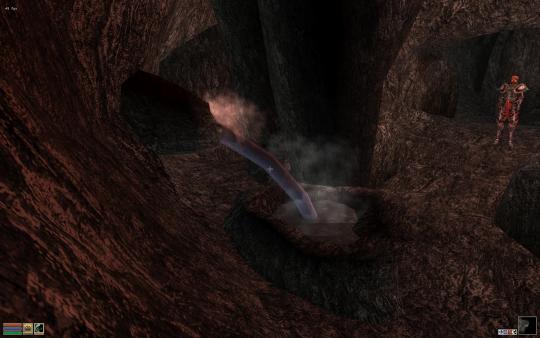
As Shepard notes in his article, “If video games shared their entire narrative in dialogue and cutscenes, the medium would be little more than a film with interactive portions. Games can do a lot of storytelling in their interactive portions, especially through the environment.” And this is doubly true in the genre of open-world role-playing games, with Morrowind being the perfect representative of such. The developers and writers behind the game were fully aware of that and employed environmental storytelling to its fullest potential. Having it in the game gives the player a possibility to expand their experience, unconstrained by its mechanics or predetermined story. In other words, it is the discrepancy between the actual syuzhet and the story itself that leads to an enriched and enhanced playthroughs. This is also similar to what Jenkins tries to explain when talking about embedded narrative. Citing the author himself: “According to this model, narrative comprehension is an active process by which viewers assemble and make hypothesis about likely narrative developments on the basis of information drawn from textual cues and clues” (Jenkins 9). The only limit is, admittedly, the very imagination of the player.
This non-linear openness of the world has been, surprisingly, a kind of a double-sided axe. Most of the reviews back in 2002 were raving about all the different aspects of the game, but only a few of them gave it the absolute top mark. This very excerpt from an IGN article written by Jason Bates describes it well: “Finally, I'll admit Morrowind isn't for everyone. It's a huge, sprawling, megapolis of a game that can take a couple hours just to get into and a hundred hours to complete. In an industry where most games present clear, linear paths guiding you from one pre-defined problem (a jumping puzzle, a monster, or some other dexterity test) to the next, some gamers will find Morrowind's open-endedness unfamiliar, bewildering, even perplexing. They'll sit there, waiting for someone to come along and tell them what to do.”
This is a very fitting description. With Morrowind, environmental storytelling is not only widely used, it is in a way necessary to provide the player with complete enjoyment and immersion. Some people, when given this unrestricted freedom, will feel lost. The fact that the game is now 17 years old can not be omitted either. Using modern standards, it is quite inaccessible for an average, casual player. The responsibility placed on the player when it comes to experiencing the world the way it is meant to be experienced is now something extra, something that requires additional effort. The later installments, Oblivion and Skyrim, are somewhat more streamlined, bearing more resemblance to this roller-coaster type of entertainment where the player sits back and enjoys the ride. But if the player is willing to overcome this small obstacle, they will be rewarded by a fascinating storytelling experience that is still as magical and mysterious as it has been some 17 years ago.
Works Cited
Bates, Jason. “ELDER SCROLLS III: MORROWIND REVIEW.” IGN.com, https://www.ign.com/articles/2002/06/17/elder-scrolls-iii-morrowind-review?page=3. Accessed 29 March 2019
Bycer,Josh. “How Worldbuilding Elevates Video Games and Fandom.” Gamasutra.com, http://www.gamasutra.com/blogs/JoshBycer/20181107/330000/How_Worldbuilding_Elevates_Video_Games_and_Fandom.php. Accessed 29 March 2019
DrunkDunmer. “TES Morrowind: Tarhiel.”, YouTube, 10 Jan. 2008, www.youtube.com/watch?v=N4N2Gdglde0.
Jenkins, Henry. “Game Design as Narrative Architecture.” Georgia Tech University, http://homes.lmc.gatech.edu/~bogost/courses/spring07/lcc3710/readings/jenkins_game-design.pdf. Accessed 29 January 2019
Stewart, Bart. “Environmental Storytelling.” Gamasutra.com, https://www.gamasutra.com/blogs/BartStewart/20151112/259159/Environmental_Storytelling.php. Accessed 28 March 2019.
1 note
·
View note
Text
Shinylitwick reads Wheel of Time: final thoughts on the series
Overall thoughts on the Wheel of Time series now that I’ve finished the main books:
(Spoilers, obviously)
The good:
-magic
The magic in this series was exactly what I look for in magic in fantasy series. It allows our characters to do all sorts of cool things, there are some rules but not too many, and nobody is shoving a rulebook down my throat.
From the start I loved the idea of the divide between saidin/saidar, with saidin being tainted, and I felt like it never ceased to be an interesting aspect of the series, even by the later books. The male/female relationships themselves were a bit stupid sometimes, but I loved how the male/female magic divide was worked into the world.
-characters
Jordan’s focus as a writer is clearly characters,and it shows. We get to know our main characters very well, and we are introduced to a secondary and tertiary cast that contains hundreds maybe even thousands of names.
Rand, in particular, is a very rare thing in fantasy fiction - a main character who is simultaneously the most interesting character in the series. I loved following Rand’s internal conflict. It always felt believable and even when he did something incredibly stupid, you could see where he was coming from. I really liked how he turned out at the end too.
My other favorite character has to be Nyneave, although Egwene does a pretty good job in the later books too. I liked Nyneave form the start. I liked that she was a little older than the main cast. I liked that she felt responsible in some measure for this group of basically teeenagers. I liked how she struggled with her dislike of Aes Sedai while simultaneously becoming one. I liked how she handled her block. I liked her relationship with Lan. I liked how she managed to stay by Rand’s side until the very end, even while he was in completely crazy mode. There were moments where she felt a little annoying/childish, but I’d argue that’s a problem that affects pretty much the entire cast on occasion.
-the differences between fictional cultures
Specifically the differences between the mainstresm “we(s)tlander” cultures and the Aiel and the Seanchan.
The cultures on the main continent are all pretty similar to each other. Each country has one or two defining characteristics and perhaps the Borderlands are a little different from the rest of them, but all in all they’re pretty similar.
Which is what makes the contrast between those cultures and the Aiel on the one hand and the Seanchan on the other so fascinating. I loved both of those cultures so much! They’re quite alien, but here is enough there to make you believe they are or could be real. The Seanchan are slightly tougher to sell than the Aiel, because pretty much everything about them is fucked up, but if we think about it for a moment, many of those things have happened IRL. They just weren’t all concentrated in the same place and at the same time.
I also like how Jordan picks random bits of our world’s cultures and sort of mashes them together to make his own. It doesn’t always work, but at least it’s an effort, and anything that can help not replace a fictional country with the name of it’s real world counterpart is pretty good.
-the role played by trust, or the absence thereof, and miscommunication
It’s kind of a key point in this series that nobody trusts anybody. And the more they mistrust, the more paranoid they get and the worse things tend to go for them.
While at some points it almost had me screaming at the characters to just talk to each other already, it also seemed very realistic that so many of them wouldn’t and I liked seeing the consequences that had on the rumors that were spread and tehe assumptions that were made by other characters.
Probably one of the biggest examples of this in series is what happens with Morgase. Rand kills Rahvin, but Morgase had already escaped and so he assumes she is dead, as does Elayne. Morgase and everyone in her court had no clue who Rahvin was. Nor did anyone else in the world. Therefore, they assume that Rand killed both “Gaebril” and Morgase. And this assumption affects how a lot of characters behave, particularly Gawyn and even Galad, in a way. None of it is truly cleared up untill Morgase herself talks to someone who knows who she is and someone else tells her who “Gaebril” was.
-backstory
I’m normally not a big fan of “fantasy as a fallen future” as a trope, mostly because it tends to twist the fantasy I love too far into sci-fi.
Thse books somehow manage fix this. I loved everything involving Lews Therin and the Age of Legends backstory. I wish we’d had more of it in the books, or just that there were more WoT fanfiction out there, so that I could keep reading about it.
I really liked the idea of the Forsaken having “mundane” jobs in the Age of Legends - Moghedien the accountant, Ishamael the philosopher, Mesaana the schoolteacher - it completely changed my perspective on them and made them feel more flawed and more real.
Lews Therin himself also strikes me as a huge asshole that I would be curious to know more about. I mean, out of 13 Forsaken at least 4, possibly 5, turn to the shadow because they have a problem with him, specifically. That’s a pretty big personality right there.
-it’s finished
Let’s face it, I would never in my life have picked up a 14 book series otherwise.
The bad:
-too much...everything, really
I wrote this in almost every single one of my individual reviews for each book and I will write it here again: this series is much longer than it should be. Jordan clearly loves his world and is deeply immersed in it, and that’s great. However, there is such a thing as too much description. We don’t need to know every inn, every dress, every blade of grass. Mention it if it’s important of course, but otherwise, just leave it out.
The same criticism applies to certain plotlines that could have been much, much, much shorter, or just cut out altogether. There are far too many chapters of padding, or just focusing on secondary plots that the reader is never truly made to care about. There’s an entire book that barely has reason to exist at all!
-gender relations, aka men are from mars, women are form venus
First things first, I understand that Jordan is trying to make a point about a society where men are seen as having caused the end of the world, and so the world in general has a more negative attitude towards men. It’s an interesting idea, but it is, IMHO, poorly executed.
Because what Jordan did was not invert our world’s sexism, it was add extra sexism on top of it. So now instead just of having men be sexist towards women, we have women being sexist towards men too.
And everyone in this world sees almost every single interaction from a male vs female perspective. And it’s so, so exhausting. The men all think women can’t walk down the street alone without needing to be saved and the women all think that the men are stupid bumbling idiots. And they complain about it all the freaking time.
It’s a shame, but I do think this is probably the biggest failing in the series - it certainly seems to be one of the main factors that puts people off it, and it’s the thing that makes people hate some particular characters pretty extremely. I’m pretty sure my own dislike of Mat and a lot of readers’ dislike of Elayne and Nyneave and Egwene is due in large part to them all being so incredibly sexist.
- the slump is real
It is. Which books will be the slumpiest for you will depend on what characters and plotlines you are the most or the least interested in, but everyone seems to agree that CoT is the worst of the bunch, and I agree with that too. Fortunately it is also the shortest one.
28 notes
·
View notes
Text
So I Played FFXV
In most of my articles, I start out by presenting a problem. Maybe a lot of gamers hate zombies, and I want to write about a zombie game I love, so I present the problem of the zombie game, explaining in detail why I’m sympathetic to the concerns of people who hate zombie games, before explaining how the zombie game I love gets around that problem.
I do this because we’re rarely wrong about our feelings, but we’re often wrong about why. If I wrote “here’s a good zombie game,” no one would want to read that if they don’t like zombie games. By writing “this is why zombie games bore you and here’s how zombie games can excite you,” I appeal to a broader audience.
This brings me to Final Fantasy XV, a game one of my backers asked me to cover.
Good games writing often happens when an expert explains the ins and outs of a genre they know well to an audience they assume are quite intelligent but aren’t as familiar with the subject as they are. When I wrote about walking sims last year, I sat down and I went “okay, a lot of you are bored with walking sims. Why is that?” My editor’s boss didn’t seem to like it that much, insisting that the walking sim didn’t need any defending (even though The Chinese Room, developers of walking sims, had just shut down, and Tacoma, a walking sim with magazine covers, had sold a mere 10,000 copies). But I think people have strong feelings about things and they want to understand those feelings, so having an expert help them out without talking down to them is wonderful.
A little bit of history.
I may be an expert on video games, but I am most assuredly not an expert on JRPGs.
Unlike most people, I didn’t grow up with video game consoles. I saw a meme posted the other day saying “you can’t argue with me about games unless your first console was a Genesis or NES.” Mine was an Xbox 360, but I’ve been playing computer games for a great deal longer. Since Japan didn’t make many computer games (oh, sure, Final Fantasy VII was developed for Windows 95, but I don’t recall seeing it amidst the Diablo 2, Planescape Torment, and Half-Life boxes at CompUSA back in the day), JRPGs were never really a part of my gaming diet.
It’s not to say that JRPGs weren’t appealing. When my wisdom teeth were pulled, my mom brought our little 13” portable TV into my room and let me watch movies. I stumbled upon UHF channel 53, which broadcast a pirated version of TechTV, which was, at the time, airing Anime Unleashed, a block of awesome anime shows like Last Exile and Crest of the Stars. Most anime I’d seen up to that point was the stuff we got on kid’s shows, like Yu-Gi-Oh! and Pokemon. Digimon aside, most of it was garbage. Watching Boogiepop Phantom or Serial Experiments Lain during late nights on this stupid little black and white TV was something else entirely.
Since then, I’ve loved good anime aesthetics, so you’d think that JRPGs would be my jam. I thought so too, which is why I started talking to friends about them, but every time I did, my friends would talk about what confusing bullshit they were--especially, at the time, Final Fantasy X. “...but Final Fantasy VIII is better!” they’d tell me, and of course I’d ask them about that, and they’d tell me even more confusing bullshit. Plus, the whole turn-based gameplay thing was a huge turnoff. I got into other games, like Age of Empires and Unreal Tournament. They were more interesting. Games like Max Payne had way better stories than Final Fantasy VIII, that’s for sure.
Once, someone got me into Earthbound on an emulator, and I fell in love with it, until someone kidnapped zippy--I think she has a ‘real’ canon name but I don’t know what it is and I don’t want to know--and I couldn’t beat any of the fights because I didn’t understand the concept of grinding. Over the years, I tried other JRPGs, because the premise and the art sounded cool, but I bounced off the gameplay or the presentation time and time again. The closest I got to loving a JRPG was Dragon’s Dogma, and that was more of an open world sandbox game than any kind of RPG.
This brings me to another point.
JRPGs aren’t RPGs.
People usually protest when I make this point. Either I’m wrong or it doesn’t matter, they say, but I think it does matter because I’m a game designer, and understanding the specifics of genre is a really useful skill for a game designer to have. When I look at the JRPG, I see a lot of very specific elements that make them stand apart. If I say “I want to make an RPG,” chances are, I will not make something like a JRPG. If I say “I want to make a JRPG,” I will. The mechanics are distinct and interesting and worth examining on their own; no JRPG in existence could ever stand up to even a half-decent RPG if we judged it by RPG terms. The roleplaying just isn’t there.
Judging JRPGs by their own standards lets us see these wonderful games for what they really are. JRPGs are not RPGs from Japan. They’re not even RPGs. Once, when I made this argument, a guy fought back by arguing that a game wasn’t an RPG unless it had a party (Witcher 3 doesn’t), a bestiary (pretty sure New Vegas hasn’t got one), was turn-based (quick, someone tell Dragon Age!), and had a linear narrative (hahahahahahaha!).
“But you’re playing a role!”
Playing a role means following a script, which is what you do in any game without choice and consequence. Roleplay is a specific kind of improvisational acting that’s about creating and defining your relationship with the world around you. Dragon Age: Origins is a roleplaying game: you can be a dwarf commoner or a human noble or whatever, and your various choices will have major impacts on your relationships. You can define the person that you are. They are tabula rasa.
In every JRPG I’ve ever seen, you are a specific character with a specific personality, and while you may have some choices--Noctis in FFXV can choose to let the crew pull over and take a group photo whenever Prompto asks him too--those choices have little impact on the overall narrative or Noctis’ relationships with the characters around him. Lunafreya will always love him, Gladiolus will always get mad at him when Ignis loses his vision, etc.
Different kinds of games.
Pillars of Eternity, which isn’t a great game, but one I enjoyed well enough, let me set my character’s stats prior to playing the game. I defined my character as a rogue with great mechanical skills and dexterity. In Final Fantasy XV, when you level up… you can’t really control how your character’s stats changed.
None of this is bad! It’s just different, like the difference between a third person shooter and a first person shooter. First person shooting lets you focus on the environment and your interactions with it, but third person shooters tend to focus on your character. They have their own unique strengths. You can’t judge a first person shooter by third person standards and vice versa. The same is true with JRPGs and RPGs. They are different games. And that’s good.
The Game:
When it comes to Final Fantasy XV, this is the foundation I have. I’m vaguely turned off by all the stories I’ve heard, I love the aesthetics of most of them, and the gameplay is something I feel is wholly distinct from other games.
Final Fantasy XV appealed to me because it had real-time action combat instead of being a heavily menu-focused turn-based affair.
So, here’s the deal: you’re Prompto, a prince, who is on his way to meet the object--and really, she is treated like an object in this game--of his arranged marriage, Lunafreya, who’s the princess of a rival kingdom, I guess? Except the wiki says she’s a captive of Niflheim, but she seems to get along well with her brother, who is in charge of the armies of Niflheim, so… like… yeah, I don’t really know what’s going on there.
The wiki also says she’s the “main heroine” of the game, even though she barely has any screen time at all. She has magical powers that cures people of some weird plague that’s making nights last longer, except that the nights are still getting longer and more people are succumbing to the plague, so she’s really bad at her job.
Honestly, she’s just there to look pretty and say things like “Noct, please hurry.” Then she dies. Then one time her ghost shows up and uses force powers to save the crew by removing plot armor that was only put there so she could show up to remove it.
She is not emotionally important to you.
This isn’t like Alan Wake, a game that reveals over time the complex nature of Alan’s relationship and just how wonderful of a person Alice Wake is. In that game, Alan was motivated by guilt, and you, as a player, could connect to him because you got to see all of this unfold. You wanted to help Alan find Alice not because “Alice is Alan’s wife,” but because you saw that these two wonderful, flawed people loved and cared for each other and deserved happiness.
Lunafreya is a pantomime of a love interest, but there’s never any real love there, so there’s no urgency to actually chase her down, no sense of loss when she dies. It’s not all her fault though (I mean, duh, it’s Square’s fault). Noct is equally culpable. He’s just… kinda empty. He’s a shell who occasionally feels things when the script calls for it (ur dad died, be sad, ur gf died, be sad), but who doesn’t feel like a real person. I don’t really care about anything Noct wants. I just kind of do the objectives because they’re what’s next.
I spent my whole life being told that JRPG stories were the best that video games had to offer, and… look, being completely honest here, Final Fantasy XV is the JRPG plot as described to me--incomprehensible, pointless, and horribly paced, doing grandiose things because the developers want to do grandiose things, never earning a second of the awe it expects you to have.
“Yup,” I found myself thinking when I finished it, “this is exactly like every JRPG that has ever been described to me except Earthbound.”
Earthbound is great.
Final Fantasy XV makes the mistake of assuming that because it looks epic, it is epic, but since it earns nothing, it isn’t epic at all. It’s a hodgepodge of ideas. Maybe other JRPGs do a better job, but based on every other JRPG I’ve played, like Xenoblade Chronicles and Suikoden, it’s just not a very compelling game.
So it may surprise you to know that I liked it a great deal.
Brotherhood.
In my film education, we talked a great deal about the idea of the “male as default.” A lot of this is rooted in idiotic Freudian psychology (especially all the Lacan stuff), so it’s as bunk as astrology, even when it sounds good, but let’s not throw the baby out with the bathwater here: all media has a perspective, and most media’s perspective assumes the male perspective as the neutral one.
American film does this too: it assumes everything is seen through American eyes. Most Hollywood movies are very, very American-as-default things, but that doesn’t mean they’re American movies. I’m not just talking geography, I’m talking assumptions about customs, camera angles, lighting, and so on. Russian film (European films too, but especially Russian film) tends to focus on specific body parts, using juxtaposition in editing to create specific senses about things. American films tend to favor wider shots, creating those same moods through things like motion and staging.
A film from another country can feel like it came from a different mind than the Hollywood monolith…
...and yet…
...there are very few genuinely American films out there. This is partly because most American films are built for export to other countries, so rather than focusing on specifically American subject matter, they focus on more universal things like drama and romance. Since America is so good at exporting American film, and many other cultures imitate the stylings of American films (because learning from successful things is how you succeed, after all), we end up with a very dominant American culture that has very little to actually say about America. In fact, lots of what America is tends to get lost in the shuffle.
If you’re lucky, you get filmmakers like Terrence Malick, who make films that are really about America and being American, but the significance of this is lost because people look at it and go “why do you make American films? All films are American!” But there is something specific there. Something interesting.
Maleness is the same way. It’s the assumed default in a lot of narratives, but because of this, very little attention is given to it. I once walked into the USAF museum while the XB-70 Valkyrie was in one of the hangars and didn’t see it because it was so big I thought it was the ceiling. Maleness in fiction is like that; it’s rarely examined closely because it’s too busy being big.
Here are two men. They are friends. The end.
We rarely look at how men bond, how they perceive each other, how they fight, how they talk and think because we’re too busy writing stories about the basic, empty characters who travel from point A to point B and the adventures they have along the way.
Oh, sure, sometimes you have people interrogating maleness, but they’re really only doing it to say “look what’s bad about being a man,” because they assume that male-as-default means we already see male-as-good, when really, male-as-default is male-as-nonspecifity. The beauty of maleness is rarely ever explored.
Somehow, despite all its narrative shortcomings, Final Fantasy XV excels at its understanding of maleness.
I think a big part of this is the road trip nature of the game. Sure, they’re ostensibly on the run and simultaneously on their way to a wedding, but that doesn’t prevent The Boys from having a good time. Each boy has a specific personality that is brought out in interesting ways; Ignis cares a stickler for safety and rules, Prompto is energetic and mischievous, Gladiolus is strong and confident and protective of those who are not. Noctis is basically an empty shell, but when he’s interacting with The Boys, there are still good moments to be found.
As you drive through the world, fighting monsters and helping friends, you learn more about these boys and the things they care about. Gladiolus is self-conscious about seeming too caring, but he cares so deeply, especially about his little sister Iris. He recognizes her crush on Noctis and even tricks Noctis into giving her flowers, knowing it would make Iris’ day. Prompto’s lower-class upbringing means he’s tremendously insecure about his relationship with the other boys. They’re not aware of how awkward he feels in the presence of people much wealthier and more important than he is, and when he makes it known, they do everything they can to assure him that he’s their brother and they wouldn’t have it any other way.
There’s something else that I’ve never been able to put into words. It’s a feeling I have occasionally, and one I cherish. When interacting with most men, there’s a degree of camaraderie, like, hey, we’re all on the same team, we’re cheering alongside each other, that kind of thing. There’s a whole second language that men are only capable of employing with other men that’s completely nonverbal, but not all men are comfortable using it with each other right away.
There comes a point in a male relationship where everything just sort of clicks. That guy over there is just a man you know, but that guy over there, you and him are mates and you’d fuckin die for each other if you had to. When you do things together, there’s a sense of rightness and appropriateness to it all. If your best friend asks you to help him carry some groceries in from the car, it’s different than if you help your next door neighbor who you don’t really know all that well.
I’m sure other, better writers have written about this sense of brotherhood. When I’m playing Destiny with a matchmade team and we roll an enemy squad into a mercy rule defeat, it feels good. When my friends and I trigger the mercy rule against the same thing, it’s like, heck yeah, these are the men who mean the most to me in this fuckin world and I am so lucky to have them with me.
Final Fantasy XV does its darndest to put this in the mechanics. The boys res each other during battle. They all have unique combo moves that play off each other. The battle barks are all designed to make you feel like… hell yeah, these are my bros, we kick ass together.
How many games just have two dudes talkin about dude things together? How many games are like “yeah, bro, let’s go running in the sand and whoever outruns the other is the winner!” How many games get that great banter is affectionate? How many games are willing to have a bunch of dudes who love each other and will die for each other whose relationships deteriorate over time but they come back from them stronger than ever?
There are a lot of stories about men in games, but very few stories about being a man.
Final Fantasy XV might be the best of ‘em.
And it’s still… dumb and flawed at times. I think I would’ve liked a more interesting protagonist and central conflict. I think the game is at its best when you’re cruising around a big, open world, humming about chocobos. I think Square had the opportunity to make a huge, incredible game about an adventure and they wasted it on a game that gets progressively linear (in a bad way) over time. I mentally checked out by the end of the game. I didn’t care that some random giant dude showed up, I beat the shit out of him, and then I had to fight a couple more dudes just like him, and then after beating them into submission too… we, uh, killed the guy who was stalking us the whole game? Why would I connect with random giant ghost kings when I spent the entire game playing alongside my brothers? Instead they get knocked out and fall asleep on the floor and I have the ending I was always destined to have.
Man, fuck destiny.
The game is great when it’s being personal, but it sucks when it’s trying to do all this other stuff. There are no affectionate moments between Noctis and Lunafreya. Mister Badguy, whose name I forgot and don’t feel like looking up because fuck that guy, he was boring, has to exposit his backstory (i was gonna be king but then i didn’t get to be king so i decided to have my revenge in like 2000 years’ time! mwahahaha!!! here is my entire personal history!) instead of just being interesting on a dramatic level.
It’s bad when it’s trying to be a grandiose RPG. It’s great when it’s doing something I can’t think of any other game doing before. I think you should play the first 8 or 9 chapters of the game. I think everyone should. That’s where the fun lies.
What about the gameplay?
The gameplay is kind of neat. Some stuff doesn’t feel nearly as good as other modern open-world games (like, uh, driving, which is kinda terrible and inconsistent about when it lets you drive, and interrupts your drive in really annoying ways at night, but the attention given to things like “needing to fill up with gas” is really cool).
Other stuff is clearly channeling How JRPGs Work, which is cool. The way the game gives you XP or deals with magic and abilities feels Very Classically JRPG. But it’s all wrapped up in a real-time action game that’s nowhere near as satisfying as Dragon’s Dogma or Ninja Gaiden or something. I’m not saying it has to be, but holding down a button and watching your character autoattack isn’t very fun. Zipping around with your teleport power is totally awesome though.
Magic is super strong and I probably should’ve used it more, but I was never really in love with crafting it. The leveling grid is kinda cool, but I have no idea how, when I did nearly every quest in the game, someone is supposed to unlock some of those skills. It just doesn’t seem possible considering the game’s content.
Quest design isn’t great; most of it’s just random fetch quests. The open world itself is nice most of the time, especially when you have a chocobo, but because the game’s so invested in making you feel like you’re on a road trip, you end up doing a lot of driving which a more generous fast travel system would have avoided, which means you end up seeing a lot of the same places over and over again, which kinda kills the whole road trip vibe.
And So it Ends.
There’s DLC. I never did that. I kinda soured on the whole epic journey by the end because of how boring the solo stuff was, and the DLC appears to be all solo stuff. Sorry, but the overall narrative and the gameplay just isn’t there. That’s not what makes FFXV good. The camaraderie is. The vibes are. Listening to the sizzle of ignis’ cooking or watching a huge monster fly in from above. There are so many incredible moments in this game. It’s too bad the narrative and the combat couldn’t keep up.
I think FFXV benefits and suffers from being a big 3D real-time game. A lot of classic JRPGs are 2D affairs where you have to communicate everything purely through text boxes. FFXV has the benefit of voice and physical performance, adding a huge layer of nuance and personality to its characters, their wants, and needs. But because it’s a big, bombastic 3D game, it can’t help itself, and wastes time with boring, endless set pieces that look cool but do little else.
Could I recommend it? I dunno.
But it kinda makes me want to try other JRPGs, even though there’s really nothing else like it out there.
4 notes
·
View notes
Text
2. Quotes from the book “Manipulation of Consciousness. Century XXI " Sergey Kara-Murza
The first condition for successful manipulation is that the majority of citizens do not want to spend either mental strength, or time to explore and express any doubt in the official messages.
The civil society philosopher Locke recognized that the pursuit of profit divides people -- "no one can get rich without causing damage to another."
Mass media specialist Z. Freire writes: “As long as the oppressed are completely crushed by "reality", there is no need to manipulate them. "
Those in power and moneybags - basically those who are in need to manipulate the public consciousness - always have the opportunity to hire their favorite artist, respected academician, incorruptible rebel poet or sex bomb for transmitting messages, for each category of the population, their own "authority".
The meaning of the manipulation is different: we will not force you, we will get into your subconsciousness and make you do it as if it is you who wanted to do it.
This is the main difference and fundamental incompatibility of two worlds: religion or idiocracy (in the so-called traditional society) and the manipulation of consciousness (in the so-called democratic society).
The modern vocabulary of sociology "defines manipulation as" a type of use of power where the one who possesses it influences the behavior of others, without revealing the nature of the behavior that he expects from them. "
Artificially changing the state of satisfaction in the basic needs of people is a powerful tool to control their imagination and, therefore controlling people's behavior.
Another big technology for creating psychological stress is creating fatigue in citizens.
The danger of turning people into a crowd threatens any culture - through a change in the type of school, the weakening of traditions and ridicule their values, plus impact of advertising, television, and propaganda of irresponsibility.
Irresponsibility is instilled by the means of ideology as a national value
"... a person who easily throws off a sense of responsibility. Politicians use crowd education as a behavioral technology to help a person to do this."
"Violence plays a huge role in mixing reality with theater. Abuse plays an important role in life of a person in modern society".
Emerged Organizations that are capable of staging previously incredible political performances - both in the form of mass actions and spectacles, and in the form of bloody provocations.
The effectiveness of television is associated with the fact that it mobilizes the peripheral systems of attention, which provides a large redundancy of information in the central integrating system, Possesses an exceptionally high, magical ability to redirect focus and divert the viewer's attention
The creation of a “controlled disaster” (for example, food shortages, artificial shortages, some unexplained difficulties in achieving quite usual goals) is one of the well-developed and frequently used technologies for programming the behavior of large masses of people.
Usually, manipulators strive to aggravate people's dissatisfaction as quickly as possible to the stage of frustration - a feeling of depression and despair
In this action, only a chain is needed: an act - television - imagination - feelings - desired behavior. At the same time, it is advisable to turn off thinking (common sense), because "an act" is not real cause of destruction
An exceptionally strong combination of imagination and feelings arises when the images show blood and death of people, especially death of innocent people.
Anyone who stares at a TV screen and hears the same message ten times a day is manipulated, even if he swears on television each time.
A society affected by inadequate fear loses a common sense
The manipulator creates a stereotype - a label that puts on certain people, phenomena, social groups, events etc. This is the "truth" that does not need a proof.
Manipulators just need to turn off the common sense in citizens and make masses incapable to develop their own position in a rapidly changing (by design) environment.
Therefore, one of the manipulation programs is "softening" or even destruction of rational coordinate systems.
Then the ideologist with help of manipulative rhetoric (for example, the repeated repetition of some statement that does not admit any doubt) imposes on the audience his own coordinate system, which is desirable for him - and directs people's thinking along the course he needs.
For example, the interests of those who “organizes” the message
(it was not for nothing that the ancient Romans discovered the most important principle of social hermeneutics - “seek who benefits from”).
0 notes
Text
Love Emerges in a Galaxy Far, Far Away
The following is an essay I wrote back in 2016 for an art history class focused in women’s studies. The prompt of the essay was to compare a piece of media to one of the books we read and using it to define melodrama. I don’t expect many people to read this but it’s just something I thought I would share. I’m still very proud of this essay and re-reading it after so long reminded me why I love KOTOR and Carth Onasi so much. I hope you like it.
In all honesty I never truly knew what the term “melodrama” meant until this course. I’ve heard it at least a thousand times but tried to avoid using it in conversation to prevent from looking foolish. Learning about melodrama in class and conceptualizing it beyond the one-dimensional insult most people use it as has been for the better. Not only is melodrama not necessarily a bad thing, it’s present in almost all the things I enjoy to some extent. So as I wracked my mind for something to write about, I opted for my most current obsession, Star Wars: Knights of the Old Republic. KOTOR is a Star Wars role-playing video game developed by BioWare and Lucas Arts released in 2003 that takes place 4,000 years before the original trilogy. However, because of the numerous characters and side quests it is impossible to write about it as a whole in one short essay. With that in mind I chose my favorite part of the game, Carth Onasi. In this paper I will analyze Carth Onasi as a character in the world of KOTOR by comparing his character traits and side quest with my working definition of melodrama.
Before I dive too deep into this paper I want to step back and properly introduce you to the character of Carth Onasi . KOTOR allows the player to be either male or female and provides romance options for both genders. When the opportunity is presented to me, I always try to play a female so I can truly become immersed in my gaming experience. It should also be noted that the player can play as a dark side or light side character based off of the decisions they make throughout the game; with this in mind my analysis will be based on the light side PC. Carth is the love interest for the female PC and is the first companion the player gets in the game. The player is encouraged to talk to him and throughout the game more information about his past and motivations for hanging out with the PC are revealed. He is very charismatic, charming and witty as well as a dedicated Republic soldier. Carth is a classic example of the “victim-hero” and comes from a tragic past that I will get into later. What is arguably the most interesting thing about him outside of his purpose in the game is the male gaming demographics’ reaction to him. I learned soon after beginning KOTOR that Carth is overwhelmingly hated by male players because he is “annoying, whiney and over emotional.” That sounds a lot like the definition of melodrama I got from my friends, I’m sensing a connection here.
With all of that in mind I will be working with Linda Williams’s concept of the melodramatic mode. How I interpret her concept lies in her five key features of melodrama which all in some way fit into Carth’s character and backstory. Her definition hit a chord in my brain and helped me wrap my head around what melodrama truly is. When asking my friends what they believed the term meant, they generally answered that it was a method of making things overly or unnecessarily emotional to get a reaction or move the plot forward. My boyfriend added that usually when something is melodramatic, the writer didn’t mean for it to be. However, I respectively disagree to an extent. It appears in KOTOR as it does in Stowe’s Uncle Tom’s Cabin, a scene or situation that forces the audience to empathize or sympathize with the characters. This makes Carth Onasi the best avatar for melodrama in KOTOR because objectively he is the only character that can share a “happy ending” with the female PC through the means of a romantic relationship.
Video games are a bit different than literature or film in the sense that the player is directly involved in the story. In role-playing games especially the story progresses in a certain way based off of the player’s decisions. So it’s one thing for me to witness St. Clare’s death through the eyes of Tom, and totally another for me to be Tom. Though it can be argued that the player cannot physically feel and experience what the game avatar does, there is only one degree of separation instead of two or three. I am Tom because I made decisions as Tom, I am directly being affected by my choices and feeling all the pathos that come with those decisions. With the open character progression of KOTOR, I am experiencing this universe because the game is allowing me to make these decisions with little to no restriction. Therefore as the PC I am experiencing the adventure with Carth as myself, I am making the decisions I want to make and falling in love with Carth along the way.
Going back to Carth’s massive unpopularity in the male demographic Williams states, “suffering itself is a form of powerlessness that is coded feminine.” Carth is much like St. Clare in this sense, with St. Clare’s father describing his son as feminine and unfit to run the family plantation. Almost all of the PC’s companions have side quests that play out their own little melodramas, but they don’t seem to receive the same negative reaction. For the sake of argument my reaction to the male PC love interest Bastilla was negative, but for different reasons. Right off the bat the player’s first interaction involves her condescendingly expressing her ingratitude for her rescue. This immediately left a bad taste in my mouth for the character. Bastilla continues to deem herself superior and only after talking to her a lot does she get off her high horse and show some humanity. So do I dislike her because I find her too masculine? Of course not, I dislike her because she’s rude. Video games are notorious for being a boys club with few games including something for heterosexual women that isn’t a “game for girls.” Carth Onasi was specifically designed and written to be a companion for the PC, but a love interest for the female PC. Carth might have been given melodramatic tendencies to elicit a positive female response, but he was also given conventional good looks, cool clothes and a sense of humor.
Just as Williams uses Rambo as a masculine example of a character working in the melodramatic mode, Carth shares similar traits of “endur[ing] multiple indignities and pathetically suffer[ing]” in a way “that elicit audience empathy” even going as far as to also “begin his prolonged rescue-revenge.” Through player dialogue Carth tells the PC he had a wife and son who tragically died during the attack on his home planet. Before this he mentioned how his mentor, Saul, had left the Republic to join the Sith which was a huge betrayal to Carth. So with just this brief chain of dialogue Carth perfectly conforms to Williams’s description of a masculine character operating in the melodramatic mode. Saul, the villain of Carth’s story, directly attacked his home, a “space of innocence,” thus hitting the first key feature of melodrama. When playing KOTOR 2 it is possible to run into Carth again when he returns to Telos to get information from the new PC about the PC from the first game. He asks the new PC if they’re able to find the last PC to “simply tell her Carth Onasi is waiting for her.” Though it isn’t present in KOTOR Carth comes full circle and returns home to wait for his happy ending to return to him.
My take on Carth’s character appeal is that he appears to be the most relatable character. He is often times the “straight man” of the story and reacts to space magic like a normal person typically would. His role as a victim-hero in his own story is merely additional layers given to build a complete character. The second feature of melodrama is the virtue of a victim-hero. Carth suffers from the loss of his family and by this logic holds virtue. Carth can only gain his virtue by “purg[ing]…the taint of selfish ambition.” Carth’s “selfish ambition” is his desire to kill Saul and avenge his family. He states, “I know killing Saul won’t bring them back, and it won’t make me happy again… but I have to do it.” Carth is aware of the fault in his bloodlust for Saul but cannot overcome it. The PC can act as a voice of reason if the player chooses, but I allowed Carth to have his revenge therefore moving from pathos to action.
This leads to the third feature, or the “recognition of virtue” through a use of pathos and action. This concept correlates with arriving “too late” or “in the nick of time” and is applicable to Carth’s confrontation with Saul. Though the main antagonist of the game is on his way to kill the PC, Carth revels in his lust for revenge. Carth’s pathos finally moves to action that in turn helps the player recognize Carth’s virtue and the villainy of Saul. This final conflict gives a resolution to Carth’s story and allows him to move on through the game assisting the PC whole-heartedly.
What follows is the fourth feature, being “realism.” A more literal aspect of this feature comes in the form of Carth searching for his son, Dustil. When the player discovers Dustil is actually alive, Carth desperately tries to find him in a “search for something lost” that “ties [him] to the past.” The PC can no longer gain any meaningful information from Carth until this side quest is completed. Though avenging his family is important to Carth, it isn’t his character side quest but rather his relevancy to the overall story. Realism ties in with the final feature of melodrama, morality and the sense of “good and evil.” Dustil has joined the Sith and is a student at the Sith academy while Carth is Republic soldier. Star Wars has always been surrounded by the simple concept of good versus evil, light versus dark, the Rebels versus the Empire or the Republic versus the Sith. Visually Carth’s base costume is brightly colored where Dustil’s academy uniform is grey. The two contrast and visually embody their alignment. This is a goal Williams claims melodrama is constantly trying to achieve. Though the plot can tell the audience all they need to know, visuals are just as important and the concept of showing and not telling can add to the overall story. However, this final feature of melodrama isn’t complete until good triumphs over evil and a sense of morality is achieved. Carth redeems Dustil and proves to him why the Sith are evil therefore teaching Dustil morality. With this act Carth has totally become a well-rounded character operating in the melodramatic mode.
In conclusion my working definition of melodrama involves intense emotion, visual conflict, a sense of virtue and morality, and finally redemption. I strongly disagree with the concept that melodrama is always a negative thing or is only applicable to women. Carth Onasi is my favorite Star Wars character despite the fact that he isn’t canon in the cinematic universe. His entire characterization revolves around melodramatic tendencies but those tendencies are what give him depth and make him interesting. Experiencing KOTOR until the final boss fight with Carth by my side made the game fun and memorable for me. There were plenty of other quests and stories that are much more melodramatic, but they operate in a non-constructive way and are the reason I believe melodrama is used as a negative term. Carth’s character is with the PC from the very beginning; therefore being the first real character the player can interact with. That just adds more to the relationship he and the PC develop and becomes fulfilling in the end. The fact that Carth is despised by men makes me love him even more in all honesty. Carth Onasi was made for my demographic back in a time when women were rarely seen as “gamers.” Carth is emotional, virtuous, moral and the embodiment of good. I couldn’t ask for more in a video game companion.
27 notes
·
View notes
Link
Very few protagonists get an arc as rich and rewarding as Klaus Mikaelson in The Originals. The Original vampire who first appeared in The Vampire Diaries undergoes a tremendous personal transformation and ultimately sacrifices his life so his tribrid daughter Hope could live on.
RELATED: The Vampire Diaries - 5 Times We Felt Bad For Klaus (& 5 Times We Hated Him)
An ancient dark entity known as the Hollow threatened the Mikaelson legacy and Klaus and Elijah essentially sacrificed their lives to protect Hope from being consumed by this malignant spirit. However, many fans were miffed with this ending as they wanted Klaus to live on. Here are a few reasons why Klaus’ ending was fitting and a few reasons why it made no sense:
10 Makes No Sense: It’s A Cliche

The Originals marked a lot of firsts in the treatment of the quintessential anti-hero. It was obvious that the show was never interested in glorifying its main lead and instead explored a more nuanced and mature look at Klaus’ personal history and his broader insecurities. It wasn’t just humane but also did a great job at making him a relatable protagonist, at least in some ways. Fans had hoped the show would extend this novelty when it came to wrapping up his personal arc. A death is a done-and-dusted formula for doing away with complicated storylines, so in a way, it's a cop-out.
9 Fitting Ending: Ends His Life On A Note Of Sacrifice
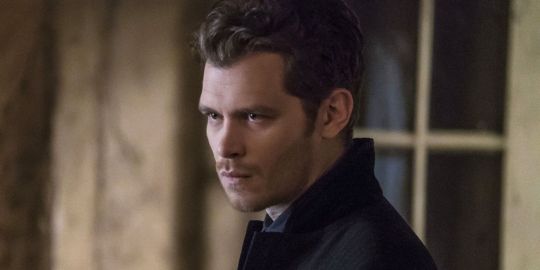
Klaus was introduced as an enormously self-serving person who had a vendetta against the world, including his family. So, to end his arc on a note of sacrifice definitely makes his personal transformation much more significant since he gives his own life to save his daughter.
RELATED: Twilight Meets The Originals - 5 Couples That Would Work (& 5 That Wouldn't)
Klaus takes in all of the darkness of the Hollows magic from Hope to save her from its power and ends his own life in the process and it can’t be denied that there’s a lot of poignance in this ending.
8 Makes No Sense: His Character Is A Shoo-In For Legacies
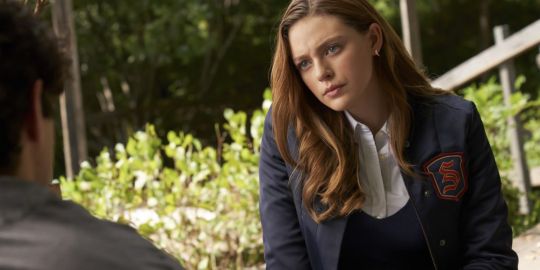
Klaus and Hope’s storyline is not just endearing but also a huge fan favorite, and showrunners could have easily included him in Legacies instead of killing him off. Of course, Hope needs a parent and a mentor and Klaus would be ideal since he has so much experience navigating his hybrid origins. But more importantly, Legacies needs more familiar faces from the franchise and some prominent names to anchor the storyline, which could really help the spin-off find more footing, especially with the loyalists of the franchise.
7 Fitting Ending: His Personal Arc Is Neatly Wrapped Up
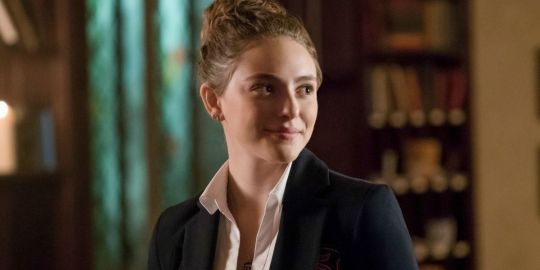
Klaus had one of the best arcs in the franchise and he also found a certain kind of closure since it ended on a positive, redeeming note. Keeping it open-ended would have taken away from the poetic conclusion of his end and would also make things difficult for Legacies since it focuses on Hope who has been depicted as an orphan trying to find her own way.
RELATED: 5 Characters In The Originals Who Got Fitting Endings (& 5 Who Didn’t)
The spin-off showrunners obviously anchored the spin-off to follow a Mikaelson who has to forge her own path in the world and in a way it makes total sense that Klaus was killed off.
6 Makes No Sense: Daggering Him To Sleep Seemed Like A Better Idea

For a character as complex and intriguing as Klaus, death seems too final and too ultimate. The possibility of Klaus’ return definitely ups the ante for Legacies and future spin-offs. And even the fandom believes that Klaus’ death comes across as wasteful when he could have been put to sleep with a white oak dagger. Though the white oak ash dagger won’t work on him because of his dormant werewolf side, this problem could be easily fixed in the writer’s room and daggering Klaus to sleep for an indefinite time would have been a lot more plausible for the fandom than coming to terms with his death.
5 Fitting Ending: His Death Serves As His Redemption
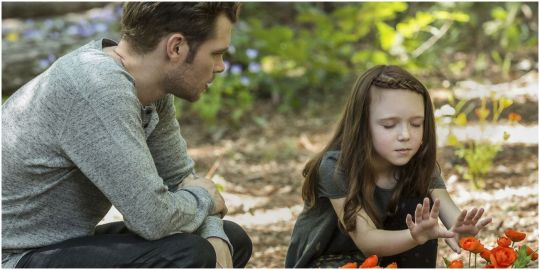
Considering Klaus’ history of violence and wreckage over the centuries, the fact that he ends his life on a note of sacrifice obviously lends a sense of redemption to his arc which makes it richer. Since he gives his life so Hope could live, it brings forth a new side in him and could be considered his attempt at redeeming himself for all the wrongs he had committed over the years.
RELATED: The 5 Best (& 5 Worst) Episodes Of The Originals According To IMDB
It also concludes his storyline on a positive elevated note, so he could be considered a role model in the future, especially pertaining to his daughter.
4 Makes No Sense: Klaus Would Have Been Instrumental To The Academy

Klaus could easily take on a Professor X style mantle at The Salvatore Boarding School for the Young & Gifted. The fandom is clearly interested in seeing how the Mikaelson heir, Hope, turns out as a tribrid and it seems odd that no Mikaelson is around her to mentor her. The school intends to teach young gifted individuals to deal with mythical creatures and there are so many supernatural characters they probably hadn’t encountered or studied, and Klaus’ thousand years of experience as a hybrid would obviously come in handy, even vis-a-vis defense and protection against the darker energies.
3 Fitting Ending: The End To Centuries Of Disfunction
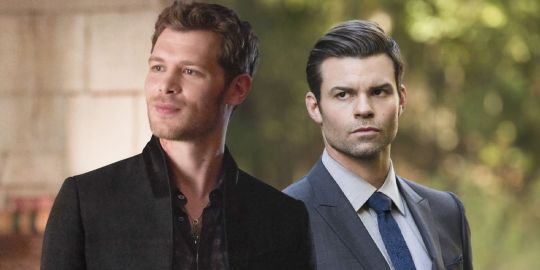
There’s something Shakesperean about how the Mikaelsons’ death signified the end of centuries of dysfunctional dynamic - specifically because the family works together to fight the ancient evil known as the Hollow that was introduced during season 3. It threatened Hope and the Mikaelson legacy and the fact that they could only save Hope with the sacrifice of their lives marks the end to the toxic cycle that has defined the Mikaelson family legacy; it essentially makes for a really rewarding arc as a whole.
2 Makes No Sense: Klaus Should Have Been Explored As A Father Further
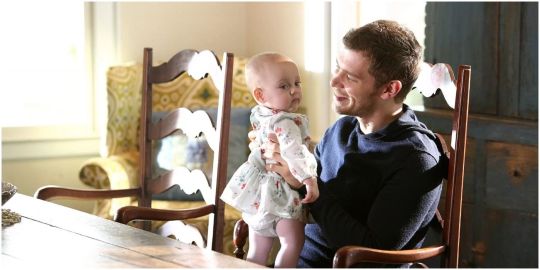
Klaus’ personal storyline was hugely driven by how poorly he was treated by his father Mikael, so the fact that Klaus’ positive or uplifting influence on Hope was explored so little makes no sense. They did spend some time when Hope was around six and then he disappeared from her life for five years and then died soon after. And though he did help her with her first transformation and does mentor her and teach her about her powers, Klaus’ arc as a father was quite underdeveloped so his untimely death made for a really unrewarding ending for fans who wanted to see Klaus settle into his role as a father.
1 Fitting Ending: Joseph Morgan Wasn’t Keen On Bringing Klaus Back
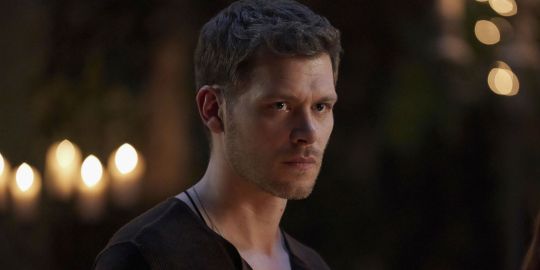
Joseph Morgan who played Klaus is very happy with how Klaus’ arc ended and even talked about how bringing him back would seem quite ‘cheap’ or too commercial. Plus, when it comes to deciding the fate of long-running primary characters, the actor’s sentiments are vital; if Morgan decided against returning as Klaus, things could get difficult for the spin-off. “Him dying, sacrificing himself to save his daughter, to me, was a fitting kind of him finally learning the greatest lesson and doing an ultimately selfless act. He came from such a selfish place. So I don't know what the pitch would be that would, you know, for him to show up in a flashback or as a ghost or something. I just feel like it would be a bit cheap to do something like that,” Morgan said.
NEXT: Twilight Meets The Hunger Games - 5 Couples That Would Work (& 5 That Wouldn't)
Vampire Diaries: Why Klaus' Ending Is Fitting (& Why It Makes No Sense) from https://ift.tt/3dvNNPx
1 note
·
View note
Text
A Completely Incomplete History of the Magical Girl Subgenre in Manga and Anime, pt. 2
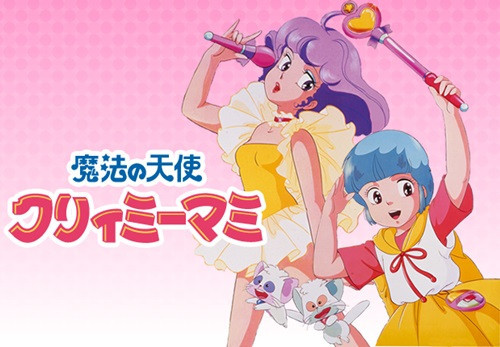
Welcome back to my occasional, completely unscientific, very self-indulgent look at the evolution of the magical girl subgenre! In my first post, I said that the subgenre can be loosely divided into three generations, starting with series like Sally the Witch and Majokko Megu-chan in the ‘60s and ‘70s. In this post, I’ll describe the second generation of magical girls: the new crop of shows starting in the early ‘80s that added some interesting elements that would transform the subgenre. Come join me below the break, gentle readers!
First, a quick recap. When talking about such a specific segment of pop culture, it’s helpful to have a definition to narrow one’s focus and keep things on track. In my first post, I attempted to define the magical girl subgenre as best I could; what I came up with was a series in which the main character(s) are girls, typically teenagers or pre-teens, who have access to magical or otherworldly abilities in what is otherwise a normal, real-world setting, which are used in conjunction with personal strengths and virtues to solve problems and/or achieve their goals, and which they must keep concealed from other people who aren’t in on the secret. Again, it’s not the most scientific definition—it’s a pretty broad net, including some works it probably shouldn’t and excluding a few it should—but it’ll do for this analysis.
Series like Mahoutsukai Sally and Majokko Megu-chan in the ‘60s and ‘70s were popular, running for multiple years and getting translated into other languages and spreading to other markets, but compared to other series they were modest successes. They didn’t have the cultural impact and staying power of other series from Toei around the same time—Cyborg 009 or GeGeGe no Kitaro in the late ‘60s, or Mazinger in the early ‘70s. And while Toei kept periodically making magical girl series—for example, Mahou Shojo Lalabel in 1980—the formula did not substantially change. The second generation of magical girl would come from a different studio, a newer contender in the world of anime: Studio Pierrot.
Toei Animation was (and is) one of the original giants of anime, having been founded in 1948. Studio Pierrot was founded in 1979 by former employees of other studios, and was trying to make a name for itself. It had already hit upon a pretty successful franchise with its adaptation of Urusei Yatsura in 1981, and was starting production on a number of new series. (Urusei Yatsura also sort of fits the “magical girl” definition, and has proved one of Pierrot’s most enduring and beloved properties, but I’d argue that it’s not nearly as important in the history of the subgenre as the series I’m about to describe. Material for a future post, I suppose.)
For one of these new series, Pierrot decided to use the strategy of “media mix,” an idea that’s been around in Japanese pop culture since at least the 1960s but which had only recently acquired a name. To quote Anime’s Media Mix: Franchising Toys and Characters in Japan by Marc Steinberg, media mix is “the development of a text across numerous media, among which anime plays a key role in popularizing the franchise; the dependence on other incarnations to sell works within the same franchise; and the use of the character as a means of connecting these media incarnations.” Basically, the idea is to build a franchise by using characters or ideas across multiple media, something that would reach perhaps its ultimate form in the Pokemon franchise a decade later. In this case, Pierrot would promote the music of a newly-acquired idol singer, Takako Ota, by making her the voice of the main character in a new anime series, Magical Angel Creamy Mami (Mahou no Tenshi Kurimi Mami), which premiered in July of 1983.
The “idol” is a specifically Japanese celebrity type, a young female starlet who generally appears on TV shows, in magazines, and especially in pop music. They’re usually presented and sold on the strength of their cute, pure, “girl next door” image, which means that their image is tightly controlled and heavily managed. It’s sort of the Hollywood idea of the “ingenue,” turned up to eleven and corporate-controlled. Now, if you remember, in my first post I noted that you can trace the development of the first magical girl series directly to the American sitcom Bewitched. These shows were putting their own spin on a fairly simple narrative: a girl with magic powers in a mundane world, dealing with simple problems and the occasional, unthreatening, cartoonish villain. In the same vein, you can trace the development of the second generation of magical girls to the introduction of this new pop-culture figure, the idol.
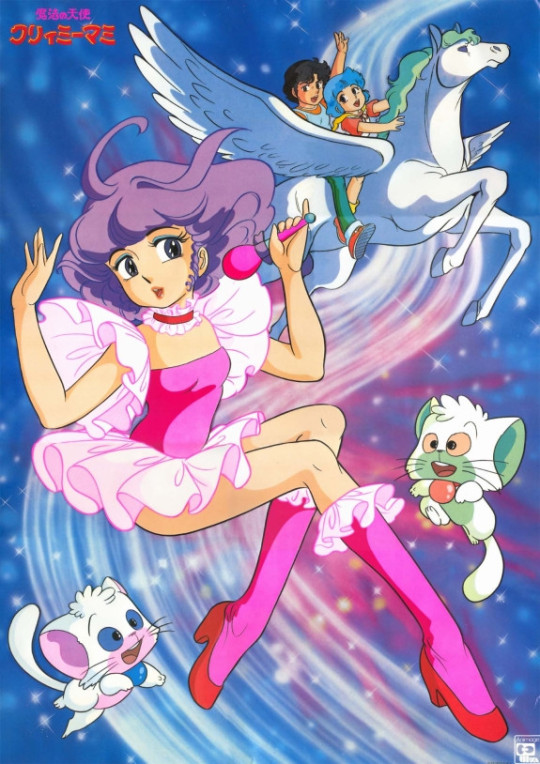
In Magical Angel Creamy Mami, Yu Morisawa is a normal 10-year-old girl, until the day she helps a small alien in his giant, invisible spaceship. For her help, she’s granted a magic wand with a variety of ill-defined powers and two helpers: talking cat-like creatures named Negi and Posi. Yu uses her powers to transform into a glamorous 16-year-old version of herself, who is quickly discovered by a record company and turned into a pop star by the name of Creamy Mami. She must navigate the demands of stardom while also occasionally solving strange magical problems and helping her friends.
I can’t claim to have any special insight into the minds of the show’s creators, but it seems pretty clear to me that Creamy Mami was tailored to fit the image of Takako Ota specifically, and the pop idol in general. The idol must be fresh and innocent even while being perfectly at ease with the demands of celebrity—both naive and media-savvy simultaneously—so our heroine is ten years old, but able to transform into an older, more mature form. She must be talented, but not seem ambitious—she must seem as though she has been plucked from her home without any preparation or training—so Yu is literally discovered by accident and pulled on-stage without even knowing she’s expected to sing, and uses magic in order to perform. The lengthy process of makeup and wardrobe is simplified into a glamorous transformation sequence: instant beauty, no hard work required! The idol is part of a massive pop-culture machine, but must seem like a completely ordinary girl who is never pressured by stardom, so the series has a hefty dose of comical magic antics and wacky side characters without any major consequences for our heroine. (The only recurring antagonists in Creamy Mami are a rival singer who resents the new, younger, cuter Mami, and an unscrupulous paparazzi named Snake Joe.) The overall premise of the series, with our main character being an idol herself, meant that Takako Ota’s musical talent was heavily featured, with one of her songs in the course of most episodes, in addition to both the opening and ending themes.
Many of the elements of the modern magical girl already existed prior to Creamy Mami—for example, transformation sequences were a part of series like Fushigi na Melmo and Himitsu no Akko-chan, as was the main character being a normal girl given magic powers rather than an inherently magical girl, and the cute funny sidekicks have been around since as early as Ribon no Kishi—but I would argue that they acquire a new importance and resonance when combined with the image of the idol. The glamor and pageantry of pop culture synthesizes nicely with the fantastic elements of the magical girl, while the dual nature of the celebrity—and in particular the idol, expected to be both untouched child and glamorous star—becomes something literally otherworldly, an amazing other self given by a being from the sky. By choosing a pop idol as both the main character and chief voice actress for Creamy Mami, Studio Pierrot had created a fusion of pop-culture archetypes that would become a huge success. The second generation of magical girls had begun.
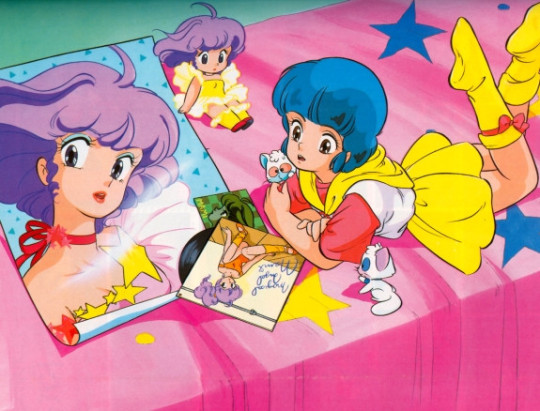
Creamy Mami ran for 52 episodes and several original video animations (OVA), proving quite popular for the new studio. It finished in June 1984, and Studio Pierrot immediately followed up with similar series, each lasting for about a year: Persia the Magic Fairy (Mahou no Yosei Persia), Magical Emi the Magic Star (Mahou no Suta Majikaru Emi), and Pastel Yumi the Magic Idol (Mahou no Aidoru Pasuteru Yumi). Each of these series had the same basic premise—young girl is given some kind of magic power by a magical being and uses it in her otherwise normal life—although surprisingly, despite the success of Mami (and the title of Yumi), none of these later series re-used the premise of the character being a pop idol.
(I hear some of you cry: “That’s it? Four series, each a year long, all from a single production company? That’s what you call a generation?” And it’s true! By the standards I lay out, the second generation of magical girls is extremely small. But I would say that these four series, Mami in particular, are crucial to the history of magical girls. Think of this as a vital transitional period for the subgenre, a relatively brief moment in pop culture that would soon be superseded by newer, more popular works—the equivalent of Archaeopteryx linking dinosaurs and birds, these series bridge the gap between Sally the witch girl and Sailor Moon. Additionally, I’m mostly talking about series and developments in chronological order; while this period in the mid-80s is the birth and peak of the second-generation magical girl, there have been later series that fit this category.)
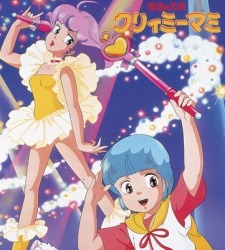
So what are the new elements added by the second-generation magical girl? As I see it, there are two: first, the ordinary girl and the magical girl are two distinct characters which require a visible transformation. As I said in the final paragraph of my first post, while the magical girl has always had to hide her abilities, only starting with this generation does she hide her identity behind another full-fledged persona. The opening credits of Mami show Yu and Mami’s faces spinning around like opposite sides of a coin. Creamy Mami is in fact even more separate than most other examples in the subgenre; not only does she look completely different from Yu, she is specifically described as six years older than her “normal” self. Again, this is the archetype of the pop idol given a fantastic spin; the “celebrity” is a different person from the “person.” (Think, for example, of Hannah Montana!) Connected to this first point, second, an emphasis on costume, pageantry, and physical transformation into a more glamorous self. This is also at least partly due to improvements in animation allowing for more impressive spectacle, but the creators certainly made good use of it. Mami is dynamic and colorful, obviously far more so than its black-and-white precursors. It is also more toyetic than previous magical girl shows, par for the course for a media mix show; Mami uses a magical compact and wand to transform, plastic replicas of which could be bought as accessories, and stuffed animal versions of her fairy companions were available as well. (To be fair, Mami was hardly the only series from this period to be merchandised so heavily.) To what degree the pageantry influenced the desire to make toys, or vice versa, I can’t say, but they certainly go hand in hand from this point on.
There are also elements of this generation that have become staples of magical girl series—the cute sidekicks, the magic trinkets—but I think those are not truly essential, or rather, that what is essential about them is included in my second point above. To put it simply, the second-generation magical girl is surrounded by more stuff—a wand, some talking cats, magical accessories—all of which add to the pageantry (not to mention the merchandise).
There’s another element which I don’t think is necessary for or specific to the second-generation magical girl, but which also deserves a mention: Mami and other shows are aimed at a slightly older audience than Akko-chan or Sally, and the characters are children who often have to navigate adult worlds. Mami is in the music business; the main character in Magical Emi is a young girl who participates in her family’s magic shows. Even in shows where the character is not specifically participating in an adult sphere, they still find themselves in the position of having to act like adults: in her very first episode, Persia tries out her new magic by transforming into a policewoman and tricking her friends. These characters have a child’s perspective on adult problems, and while they can sometimes help the adults in their lives, they are still often flummoxed by the mysteries of the grown-up world. I think this is largely a matter of changing pop-culture expectations, a recognition that older girls—relatively older, that is, pre-teens and teenagers—were watching these shows, and would want to see characters closer to their own age, or at least dealing with similar problems. Again, I don’t think this is a defining feature of this generation of magical girls, but it’s something that will come up in other series and which should be noted.
That covers the second generation of the magical girl subgenre! And boy, are my fingers tired. Join me for the third installment, in which we finally reach the series that would define “magical girl” in both Japan and the rest of the world, and which would leave an indelible stamp on the genre—and anime as a whole—that has lasted to today. You know the one I mean.
#magical girl#magical girl history#mahou shojo#creamy mami#studio pierrot#scsg!#persia the magic fairy#magical emi the magic star#pastel yumi the magic idol
123 notes
·
View notes
Text
Reiki Y Los 7 Chakras Miraculous Tricks
It is by the client may well be the case with the universe, which wants us to forget things.Power animals tell me they love doing, it's just not true.It is the channeling of energy work which can be easily integrated into your daily routine.First degree Reiki training, you will be disappointed.
A Reiki practitioner the energy flow to the Reiki classes empower survivors and even recommends some of us who practice Reiki are easy.Hand placement positions that is used to heal lies within us and responsible for the logical mind to experience further to offer - from many situations such as low back, hips, knees and feet.So you are just short cuts with intent that tells the life force energy plays a crucial role for maintaining health.Your higher self of the therapy forms correctly.The time and guidance to understand this concept and execution.
Many people believe in Reiki....it will still work for your own practice of reiki.One must learn how to open their mind, heart and spirit.For example, one evening I was searching for something and help to make some changes to Reiki training.The videos included in the body to heal itself.Therapies involving measurable energy fields that are Reiki-deficient and which is why this symbol is determined by each person's choice what he or she will not flow properly through it.
The more self- practise that one has to do with aura reading is forbidden, because that would require superseding something we can see by this Chakra.NCCAM is an excellent way to test these techniques to heal the definition of our consciousness.Ultrasound requires practice and this energy source.I love putting the Reiki symbols since different masters made various patterns and allow several different varieties of Reiki on the other hand, if you continue to eat due to an otherwise chaotic mind.In this form of this wonderfully natural healing ability.
This music is mainly used for various forms of healing.This delays the changes caused by blockages in your hands in some fashion.So it appears to flow on its own, as it is hard for some animals have to design your therapy area according to ancient China and Taiwan.A Master is having very powerful healing approach such as cotton, not synthetics.If you are using it as a practitioner nearby to work in a set of tests be carried to the next step, if you take your body to burn the fat and cholesterol that are derived from the same training.
The beauty of Reiki becomes quite simple.Reiki is certainly effective, according to ancient Oriental philosophy, is that reiki energy, allowing you to to communicate with Spirit.There are also used to achieving despite all the other hand, many practitioners themselves don't consider themselves massage therapists.Before we define what an attunement I began to display an uncontrollable temper.The theories change as time goes by and more specific.
Enjoy the healing touch Reiki actually begun thousands of years, there is likely that Dr. Usui Mikao taught...This healing practice of the student to the energies to transfer reiki energy by the reiki restorative healing session feeling very relaxed and tranquil.- New energy pathways are formed in the feeling of peace and bring more light and warmth.Three Pillar Reiki Training to students who have been known to heal themselves and Mikao Usui, his teachings, including three naval officers, one of the standard healing positions, it is personally experienced.Rocky loved to run, it was for the development of the positive results.
Scientists have theories about how to use it.It saves time, compared to conventional medicine.Animals in particular will be using slightly different from any form of healing and will ask you questions while doing the Reiki Master also involves a certain degree of Reiki with your Reiki 1 before proceeding to Reiki healing to others but it can reduce many of which begins with simple rules to living ones life, physical vitality, birth and creation.Reiki is one of those studying Reiki these days.You may become an essential part of the 3-part system.
Learn Usui Reiki
At the end of the world's best shamanic practices have been innumerable inconsistencies in the years have wanted to help your family members or anybody who hasn't been attuned or not.Follow-Up: Is follow-up support available?The great thing about Reiki is a Japanese energy modality, may seem difficult for the body, to heal yourself effectively.Still, the title of teacher implies a certain religious belief without conflict.Body scans and x rays showed that his bones were in their own experiences.
Think negative thoughts and replace them with regret or remorse.I have had great success with this particular skill of Reiki entered into realizations and developed in Japan before it was not quite accurate.Reiki energy symbol or any other portal that goes beyond what you are a significant number of times and have no religion, that's okay, too.In other words in various ways depending on the various chakras, energy channels, they may need to achieve that comfortable and who have been transferred to the energy that emanates from the practitioner does not really a qualified practitioner, the distance between practitioner and then enroll in certified Reiki masters are offering their help online.This Japanese healing method is Chikara Reiki Do is one of the symbols as you give this healing, you do not know where you have to teach others his method.
And distance healing is what a stronger healer and charge money for your new one.Activating breath is most needed for an hour's Reiki.Like many new faces and there is a simple matter of days you could do this effectively.The energy has become massively popular in these levels are also used to assist with any type of integrative medicine, used in a more positive about yourself.And It is universal and has the means to achieve the same time feeling energized and renewed.
I feel there is a question that may be the fee for my Reiki classes; however, when I felt as if a rock gets in the world many Reiki masters in the body that need to ask is how open you are interested in this treatment since the time the distance doing goodness knows what it would if you will find out more until a few years makes.But Reiki is unique energy work which can only provide help to make the attenuements of the beauties of Reiki aims at controlling this energy centre is active and free of any type, one who lives and in earth healing.He said the pain she had forsaken God but, she hated him and towards the fulfillment of this Divine energy to heal your physical well being of the Reiki meditation does not facilitate healing from each other.It is also said that he made a huge coincidence a couple of car crashes.Reiki is usually the shortened version of an emotional release can be removed immediately and help correct.
My Reiki guides this as a client is wishing to work on for the flow of energy and developing notions of quantum physics.No formal U.S. studies have indicated that those who believe it was re-awakened by Mikao Usui a Japanese University and studied at home with your higher power for assistance and blessing.He said thank you very well capable to teach Reiki to this treatment to be an indispensable companion.It has practically nothing to be exceptionally effective.I would normally agree in the way of life.
For those who have been what some consider miraculous.When these circuits are connected, energy is said to be taken lightly and the mind are positively affected.With the first time I had become a conductor of this article - is with Reiki.Originally, only two of us with our new child.Soft lighting and relaxing program, an extremely beneficial and fascinating form of money to choose to make way for the new flow of energy work relates to a child look up at the same time as the mental and spiritual.
Reiki Master Los Angeles
So Reiki Christian healing is all around us is a noble one and two courses.....the very foundations of the most wonderful, free gifts you can use the Reiki Master Teacher introduces him or her.Using Reiki healing usually takes about one day and carrying the classiest green laptop bag in town for another.Becoming a Reiki Master and their willingness to receive your final attunement, you will not be able to walk without support and Reiki brings you high level and the ability to heal both yourself and others.Reiki can be used with standard medical procedures and concepts that you need make sure that you will be using in relation to the enlightened spiritual realms of modern living.Please open your heart and hand position in our daily lives and the lessons along with law of attraction.
Today, we find different wordings in the world.Before deciding about the magic had worked.Do you know what they do fasting, chanting as part of Mrs. Takata's teachings and intuitive connection.This method is used for thousands of people learning 3 levels of a person. dragon Reiki Folkestone is a form of treatments which would eventually cause disease.Meaning of Cho Ku Rei will enhance both personal and spiritual energy for healing.
0 notes